The document critically examines the common assumption that high self-esteem leads to numerous positive outcomes, including better performance, happiness, and healthier lifestyles. It finds that the evidence for high self-esteem being a direct cause of these benefits is weak, and often, self-esteem is influenced by other factors such as actual success rather than being a primary motivator. The authors recommend caution in promoting self-esteem interventions, as boosting self-esteem indiscriminately can sometimes lead to narcissism and other negative consequences.
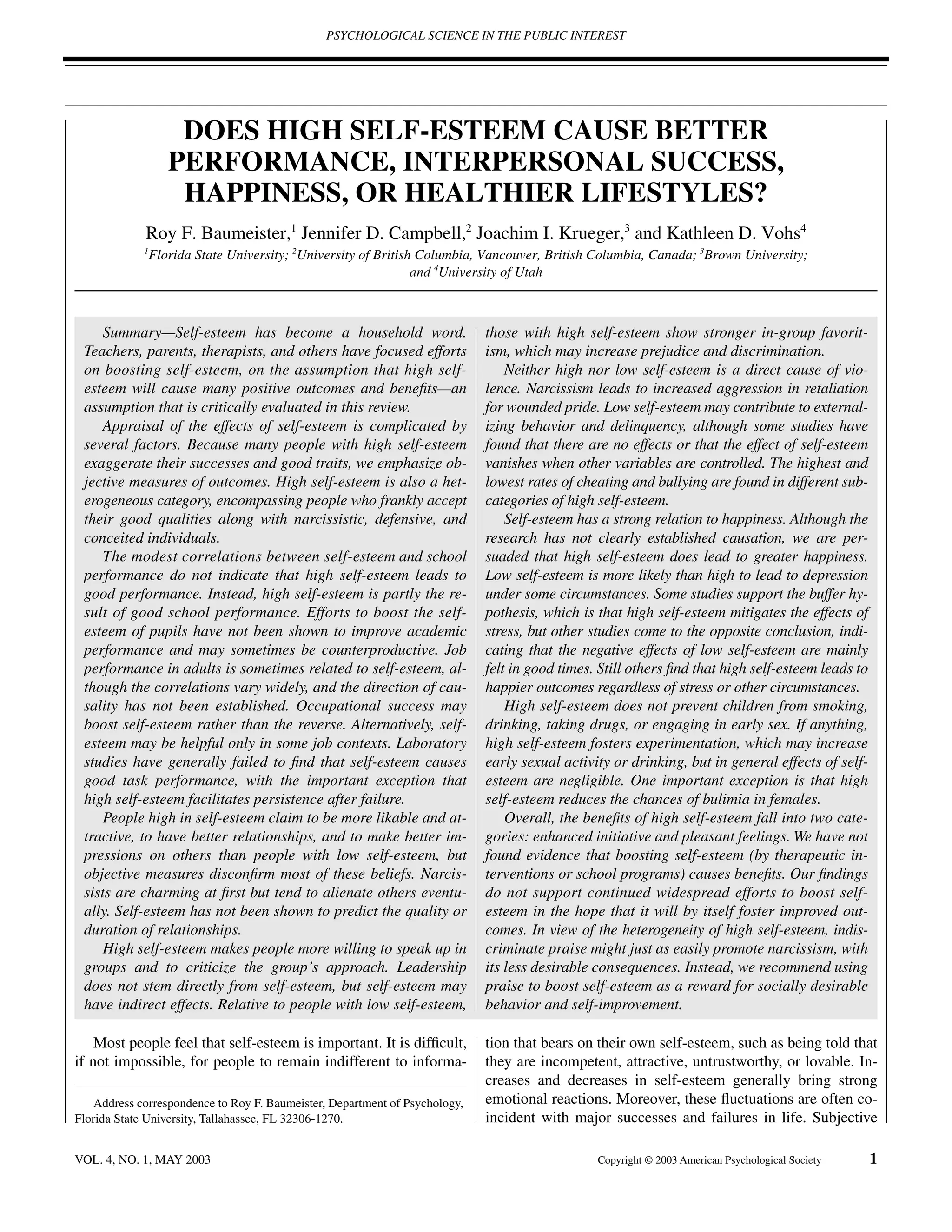

![PSYCHOLOGICAL SCIENCE IN THE PUBLIC INTEREST
R.F. Baumeister et al.
vice of psychologists. If errors were committed, perhaps psy- Academic and professional psychologists have been more
chologists should reduce their own self-esteem a bit and hesitant to endorse strong categorical claims. Eminent clinical
humbly resolve that next time they will wait for a more thor- psychologist Albert Ellis, for example, is convinced that “self-
ough and solid empirical basis before making policy recom- esteem is the greatest sickness known to man or woman be-
mendations to the American public. Regardless of the outcome cause it’s conditional” (cited in Epstein, 2001, p. 72). Accord-
of the self-esteem movement, it showed that there is a voice for ing to Ellis, people would be better off if they stopped trying to
psychology in public policy and discourse. If psychology uses convince themselves that they are worthy. Others believe that
that voice judiciously, it may still be able to make a major con- concerns about self-esteem are a peculiar feature of Western in-
tribution to the well-being of society. dividualist cultures. According to this perspective, the search
for high self-esteem is not a universal human motive, but a cul-
tural or ideological artifact. Indeed, such a motive is difficult to
The Appeal of Self-Esteem detect in collectivist cultures, and especially in Japan (Heine,
As self-aware and self-reflective creatures, many people in- Lehman, Markus, & Kitayama, 1999). Even in Western culture,
tuitively recognize the importance of self-esteem. Not surpris- the need for high self-esteem seems to be a rather recent devel-
ingly, a great deal of psychological theorizing has focused on opment (Baumeister, 1987). The Judeo-Christian tradition has
the motivation to protect and, if possible, enhance self-esteem. long considered modesty and humility as virtues conducive to
Research is showing that even psychodynamic defense mecha- spiritual growth. In this tradition, high self-esteem is suspect
nisms, which Freud originally understood as ways of keeping because it opens the door to sentiments of self-importance.
threatening sexual and aggressive impulses at bay, serve as Medieval theologians considered pride or vainglory to be par-
strategies to bolster self-esteem (for a review, see Baumeister, ticularly satanic and thus a deadly sin. To combat it, religious
Dale, & Sommer, 1998). devotees cultivated an unattractive appearance (e.g., shorn hair,
But the desire to feel good about oneself is certainly not the no makeup, unfashionable clothes, no jewelry), spoke with
only self-related motive at play. Having to cope with reality, self-effacement, and submitted to degrading exercises (e.g.,
people are also motivated to perceive themselves accurately begging, prostrations, self-flagellations).
and admit awareness of their undesirable characteristics (Swann, Such practices are but a faint memory in contemporary pop-
Stein-Seroussi, & Giesler, 1992; Trope, 1986). Nevertheless, ular culture, in which high self-esteem seems to reign supreme.
people would rather learn positive things about themselves Prodded by Assemblyman John Vasconcellos, the then gover-
than negative things (Sedikides, 1993). Although they may nor of California George Deukmeijian agreed in 1986 to fund a
want to know whether they are good or not, they much prefer Task Force on Self-Esteem and Personal and Social Responsi-
to learn that they are good. bility with a budget of $245,000 per annum for several years.
Over the past few decades, the need for high self-esteem has Vasconcellos argued that raising self-esteem would help solve
risen from an individual to a societal concern. North American many of the state’s problems, including crime, teen pregnancy,
society in particular has come to embrace the idea that high drug abuse, school underachievement, and pollution. At one
self-esteem is not only desirable in its own right, but also the point, he expressed the hope that raising self-esteem would
central psychological source from which all manner of positive help balance the state’s budget because people with high self-
behaviors and outcomes spring. This strong psychological esteem earn more money than people with low self-esteem and
claim has begun to permeate popular beliefs. Its corollary, the therefore pay more taxes (Winegar, 1990). It is easy to dismiss
idea that low self-esteem lies at the root of individual and thus and satirize such claims (Dawes, 1994). However, Vasconcellos
societal problems and dysfunctions, has obvious implications and the task force also speculated astutely about the possibility
for interventions on both the individual and the societal level. that self-esteem might protect people from being overwhelmed
The hope that such interventions might work has sustained an by life’s challenges and thus reduce failures and misbehaviors,
ambitious social movement. Nathaniel Branden, a leading fig- much as a vaccine protects against disease.
ure in the self-esteem movement, stated categorically that Concurrent with its activities in the field, which included
“self-esteem has profound consequences for every aspect of creating self-esteem committees in many California counties,
our existence” (Branden, 1994, p. 5), and, more pointedly, that the task force assembled a team of scholars to survey the rele-
he “cannot think of a single psychological problem—from anx- vant literature. The results were presented in an edited volume
iety and depression, to fear of intimacy or of success, to spouse (Mecca, Smelser, & Vasconcellos, 1989). Echoing Branden
battery or child molestation—that is not traceable to the prob- (1984), Smelser (1989) prefaced the report by stating that
lem of low self-esteem” (Branden, 1984, p. 12). Other advo- “many, if not most, of the major problems plaguing society
cates of the movement have endorsed this sentiment. Andrew have roots in the low self-esteem of many of the people who
Mecca, for example, is cited as saying that “virtually every so- make up society” (p. 1). But the findings did not validate the
cial problem can be traced to people’s lack of self-love” high hopes of the task force, and Smelser had to acknowledge
(Davis, 1988, p. 10). that “one of the disappointing aspects of every [italics added]
VOL. 4, NO. 1, MAY 2003 3](https://image.slidesharecdn.com/selfesteembaumeister-120324100051-phpapp01/75/DOES-HIGH-SELF-ESTEEM-CAUSE-BETTER-PERFORMANCE-3-2048.jpg)
![PSYCHOLOGICAL SCIENCE IN THE PUBLIC INTEREST
Benefits of Self-Esteem
chapter in this volume . . . is how low the associations between al., 1989, volume). In the quest for enhanced self-esteem, any
self-esteem and its [presumed] consequences are in research to tool in the psychological—and pseudopsychological—box is
date” (p. 15). Given that the correlations were so low, the ques- thrown into the fray, including
tion of whether low self-esteem in fact caused the societal
disparate psychological models that have given rise to such popular
problems did not even arise. notions as the “inner child”; the “self-image”; principles of proper
The lack of supportive data created a dilemma. Should a no- grieving; “super learning”; “community networking”; “relaxation
tion as attractive as self-esteem be abandoned and replaced techniques” and their effects on overall mental and physical well-be-
with more promising concepts, or should the validity of the ev- ing; the principles of “neuro-linguistic programming”; and the well-
idence be questioned? The editors and the authors opted for a founded scientific basis for the connection between the body and the
mix of these two strategies. Some retreated to a defense of self- mind and the effect of this interface on overall wellness. (NASE,
esteem on a priori grounds. Undeterred, Smelser (1989) main- 2000)
tained that Even a contributor to the volume edited by Mecca et al. (1989)
diminished self-esteem stands as a powerful independent variable argued that self-esteem must be enhanced, although its causal
(condition, cause, factor) in the genesis of major social problems. We role is far from established. “To abandon the search for esteem-
all know this to be true, and it is really not necessary to create a special related solutions . . . is to admit defeat before exploring all our
California task force on the subject to convince us. The real problem options” (Covington, 1989, p. 74).
we must address—and which the contributors to this volume ad- Was it reasonable to start boosting self-esteem before all the
dress—is how we can determine that it is scientifically true. (p. 8) data were in? Perhaps. We recognize that many practitioners
and applied psychologists must deal with problems before all
Others, however, acknowledged the limitations of the findings the relevant research can be conducted. Still, by now there are
and called for additional study, or tried to fit more complex the- ample data on self-esteem. Our task in this monograph is to
oretical models of self-knowledge to the data. Our report is fo- take a fresh look and provide an integrative summary.
cused primarily on studies conducted since the review by the
California task force. Instead of examining the merits of the
more complex models of self, we have retained the hypothesis An Epidemic of Low Self-Esteem?
that global self-esteem causes desirable, adaptive, and benefi- A key assumption of the self-esteem movement is that too
cial behaviors. There is a certain beauty to this hypothesis be- many people have low self-esteem. Under this assumption,
cause it is simple, clear, and testable. There have also been raising self-esteem becomes a meaningful goal. But what does
sufficient methodological advances in study design and statisti- “too many” mean? Self-esteem scales are designed to capture
cal analysis that warrant a fresh look at the evidence. valid individual differences that exist in a population. Thus, a
Meanwhile, the self-esteem movement was not deterred by good measure will yield a distribution of scores from low to
the disappointing findings of the task force. After it was dis- high. However, unlike some other measurement instruments,
banded in 1995, the National Council for Self-Esteem inherited such as IQ tests, that are constructed to yield symmetrical dis-
its mandate, which was subsequently taken on by the National tributions centered around an arbitrary mean (e.g., 100), self-
Association for Self-Esteem, or NASE. Vasconcellos (now a esteem scales allow skewed distributions to emerge. The
member of the California Senate) and Jack Canfield (Chicken average score typically lies far above the midpoint of the scale,
Soup for the Soul) are on NASE’s advisory board, and such often by more than a standard deviation (Baumeister, Tice, &
media personalities as Anthony Robbins (Unlimited Power), Hutton, 1989). The fact that most people score toward the high
Bernie Siegel (Love, Medicine, and Miracles), and Gloria end of self-esteem measures casts serious doubt on the notion
Steinem (A Revolution From Within: A Book of Self-Esteem) that American society is suffering from widespread low self-
are members of a “Masters Coalition,” created by NASE. The esteem. If anything, self-esteem in America is high. The aver-
mission statement of NASE minces no words about the pre- age person regards himself or herself as above average.
sumed benefits of self-esteem. Its goal is to “promote aware- The skewed distribution of self-esteem scores raises two
ness of and provide vision, leadership and advocacy for methodological issues. First, when researchers split samples at
improving the human condition through the enhancement of the median to distinguish between respondents with high ver-
self-esteem” (NASE, 2000). The goal of the Masters Coalition sus low self-esteem, the range of scores among respondents
is no less ambitious. “It is hoped that the Master Coalition can, classified as having low self-esteem is much greater than the
in a meaningful way, facilitate the actualization of society and range of scores among respondents classified as having high
lead to the amelioration, if not elimination, of various negative self-esteem. A good number of respondents in the low self-es-
influences which have operated in part to trivialize and demean teem category have scores above the midpoint of the scale. In
the human condition” (NASE, 2000). other words, the classification of a person as someone with low
It is hard not to conclude that the self-esteem movement has self-esteem has no longer an absolute, but only a relative mean-
ignored its own major scholarly document (i.e., the Mecca et ing. Second, correlations involving variables with skewed dis-
4 VOL. 4, NO. 1, MAY 2003](https://image.slidesharecdn.com/selfesteembaumeister-120324100051-phpapp01/75/DOES-HIGH-SELF-ESTEEM-CAUSE-BETTER-PERFORMANCE-4-2048.jpg)
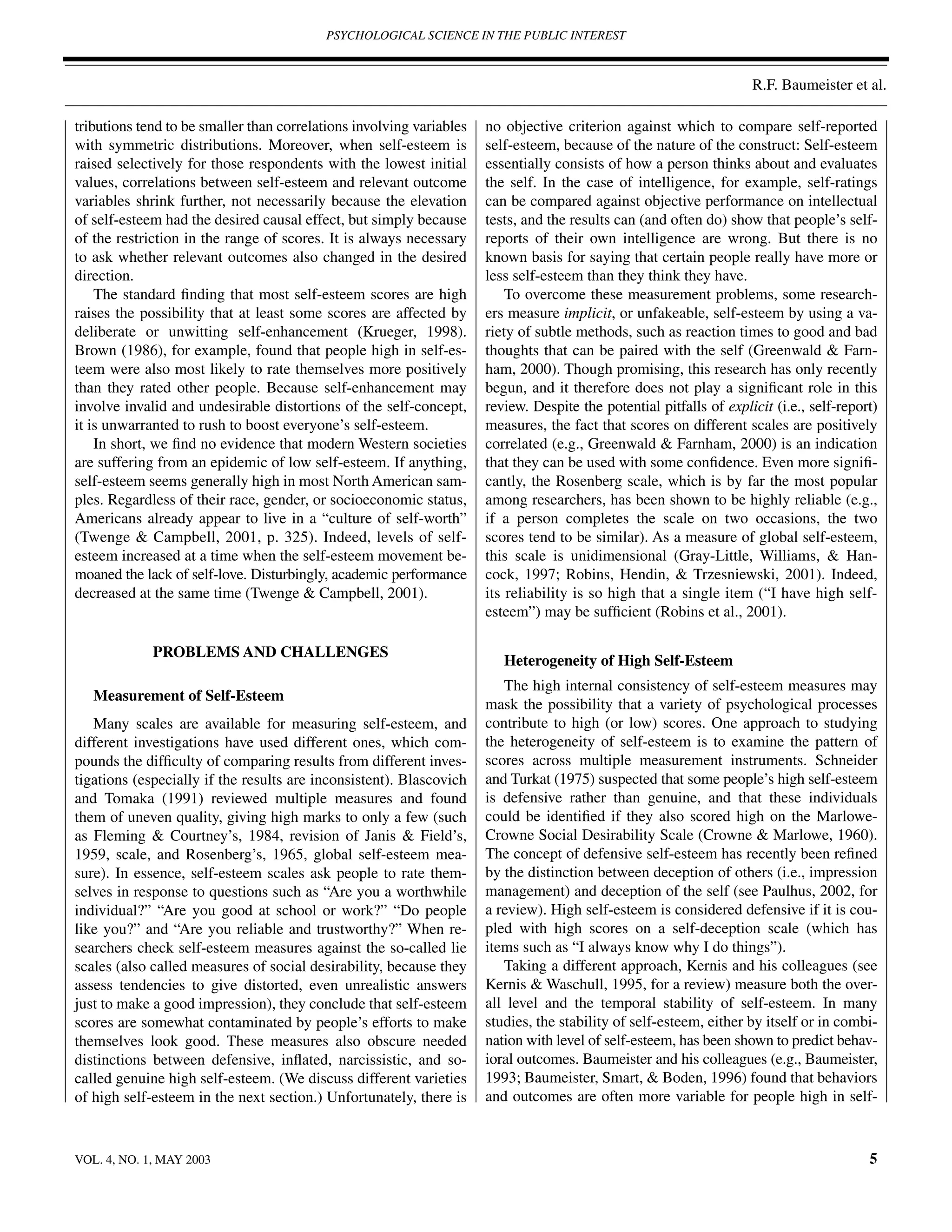
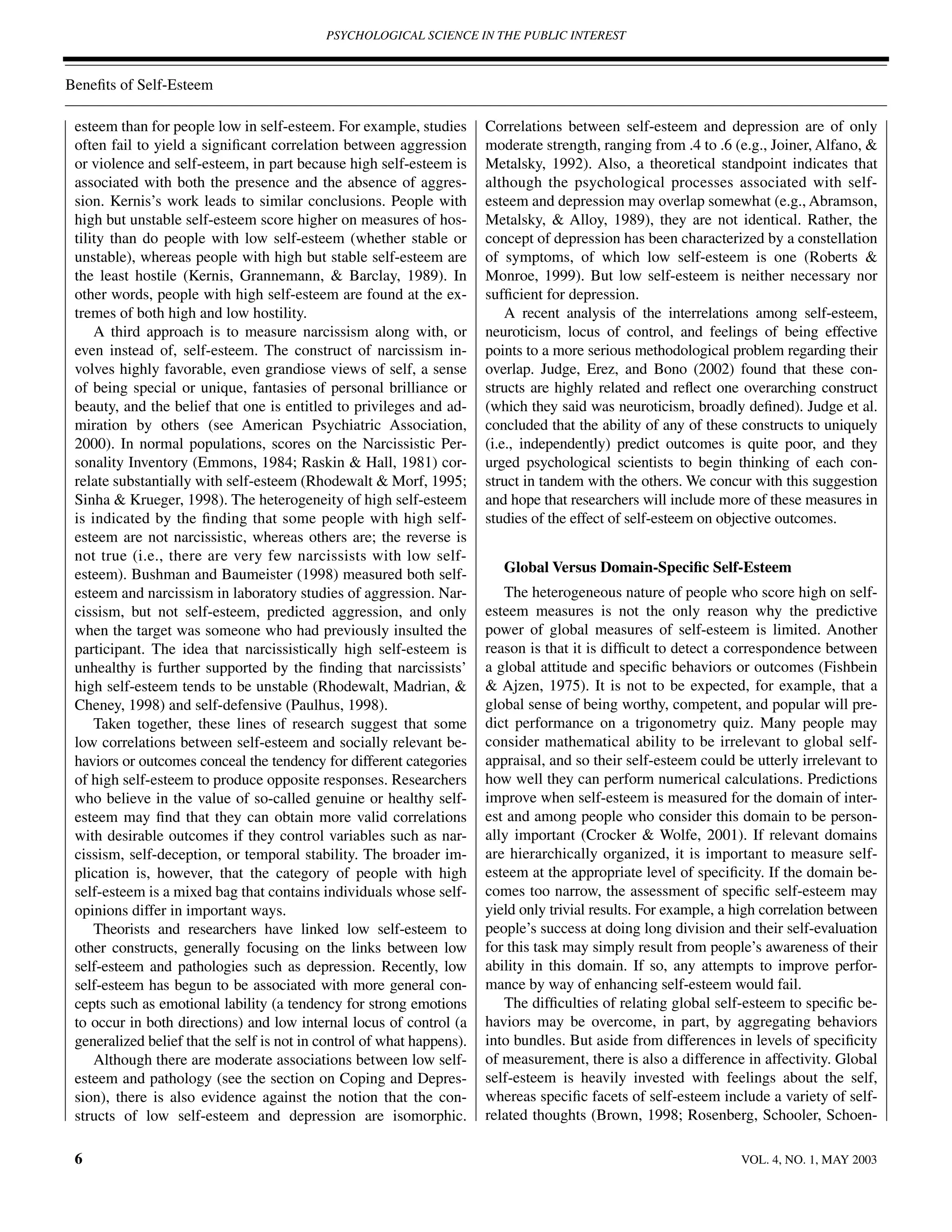
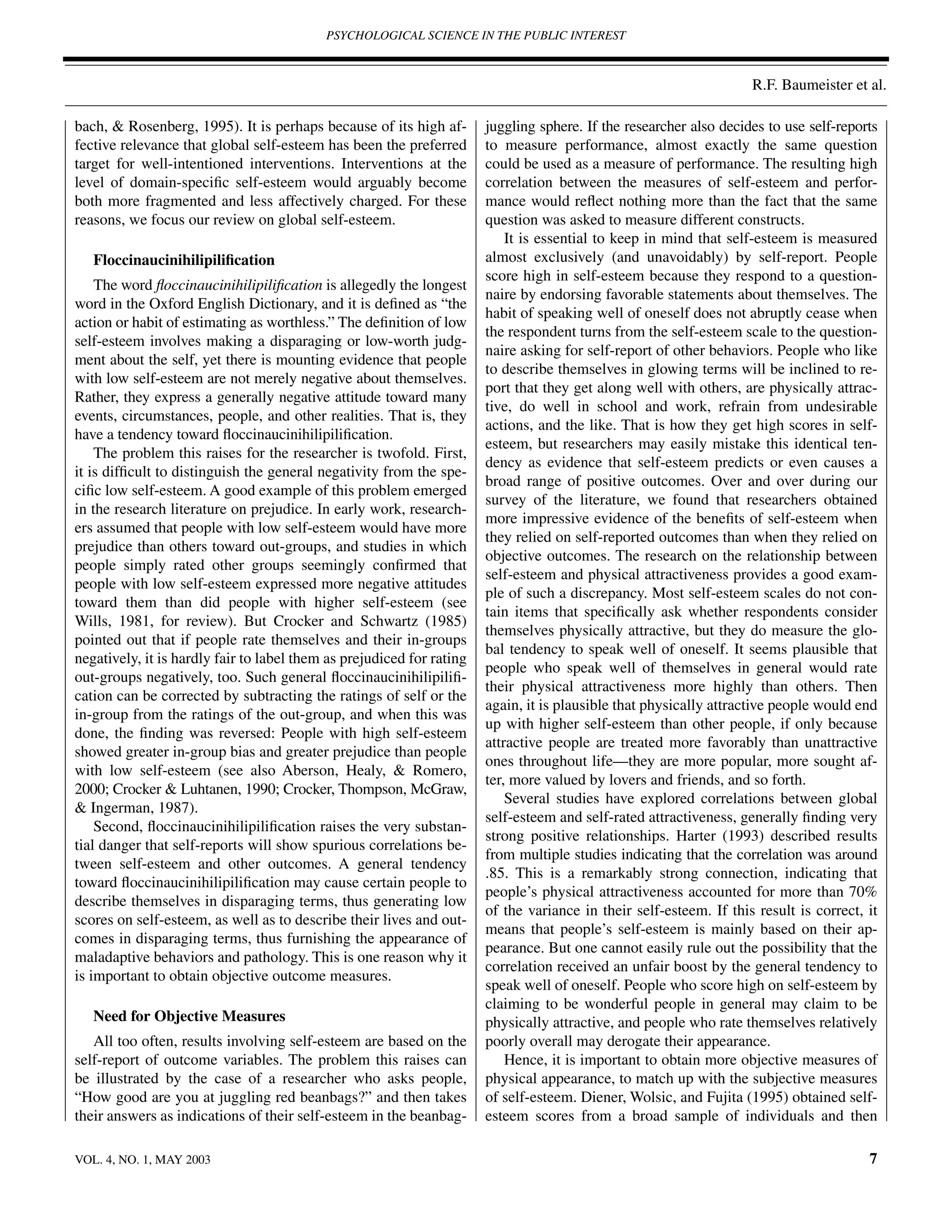

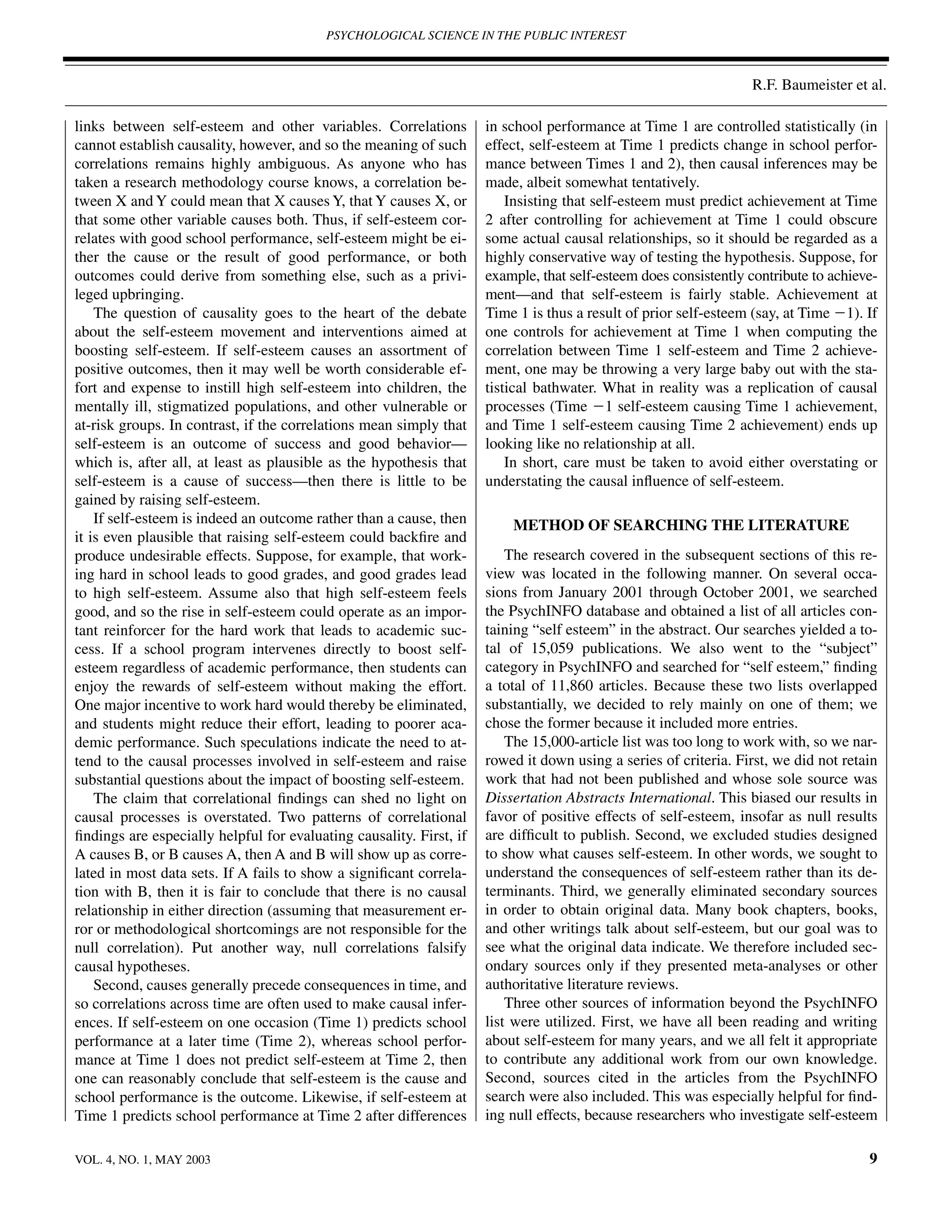


![PSYCHOLOGICAL SCIENCE IN THE PUBLIC INTEREST
Benefits of Self-Esteem
A follow-up by Bachman and O’Malley (1986) confirmed found, despite different methods and somewhat different nu-
their previous findings. In this follow-up, they sought to im- merical results.
prove their methodological rigor in several ways. One of these A slightly different conclusion was reached by Rosenberg,
was to confine analyses to White males in White-majority Schooler, and Schoenbach (1989). They analyzed data from the
schools. Although the exclusion of minorities is not considered Youth in Transition longitudinal study that was also the basis
methodologically desirable today, Bachman and O’Malley had for Bachman and O’Malley’s (1977) work. They used the 10th-
quite persuasive reasons for deciding that such inclusion might and 12th-grade data for nearly 1,900 boys, including measure-
have weakened the chance for self-esteem to emerge as caus- ments of achievement that relied on having the students report
ally significant. Specifically, in their original sample, African their grade point average in school. This sort of measure is in
American students scored lower than White students on achieve- the middle of the span of methodological rigor that we have
ment and ability tests but higher on self-esteem. Combining data outlined: It is not fully objective, but it is somewhat specific
from White and African American students could therefore ob- and verifiable. A slight tendency of people with high self-
scure a positive relationship between self-esteem and achieve- esteem to furnish self-flattering reports is to be expected, al-
ment. The authors also acknowledged that the low achievement though the scope for such inflation may be more limited than if
scores of African American students might indicate some lack respondents are asked a general self-rating question, such as
of validity of those measures for such a sample. Any lack of “How good are you at school?”
validity would make self-esteem look less effective than it ac- Rosenberg et al. (1989) did find significantly positive, although
tually is. weak, correlations between self-esteem and self-reported grades,
Despite their effort to increase the potential for their study r ϭ .24 in 10th grade and r ϭ .25 in 12th grade. Of greater in-
to demonstrate effects of self-esteem, Bachman and O’Malley terest were the findings across time. These supported the con-
(1986) found that global self-esteem had a negligible relation- clusion that self-esteem is the result of grades, rather than the
ship to eventual educational attainment. Family background cause. There was a modest causal relationship (.15) leading
(socioeconomic status), ability (IQ), and early school grades from grades to self-esteem, but the causal relationship leading
predicted eventual level of educational attainment, and self- from self-esteem to grades was only .08, which was not signifi-
esteem added little to the accuracy of prediction. Self-esteem cantly different from zero. In other words, there was no solid
was correlated with actual ability, although self-rated ability evidence that self-esteem had any effect on grades, despite the
was consistently inflated: People thought they were smarter fact that even a weak relationship would likely have been sig-
than they actually were. In short, these findings support the role nificant because Rosenberg et al. tested so many people.
of illusion in self-esteem, but they contradict the view that self- The view that self-esteem is an outcome rather than a cause
esteem causes long-term educational success. of good school performance was further supported in another
An article titled “Is There a Causal Relation Between Self- large and sophisticated study, by Skaalvik and Hagtvet (1990).
Concept and Academic Achievement?” was published by Pot- Their sample consisted of 600 Norwegian schoolchildren in
tebaum, Keith, and Ehly (1986). Their answer was a rather two cohorts, one in third grade (about age 9) and the other in
blunt negative: “The results suggest that there is no significant sixth grade at the start of the study. A second set of data was
causal relation between self-concept and academic achieve- obtained a year and a half later. Achievement was measured by
ment [in either direction], but rather that the observed relation teachers’ ratings, which furnish a good measure although erro-
is the result of one or more uncontrolled and unknown third neous perceptions by the teacher could affect a student’s self-
variables” (p. 142). A great deal of methodologically sophisti- esteem (e.g., if the teacher treats the student as a genius or dull-
cated work went into producing that conclusion. Pottebaum et ard). Skaalvik and Hagtvet found evidence that doing well in
al. used a sophisticated research design, testing a very large school one year led to higher self-esteem the next year,
sample of high school students (more than 23,000) in the 10th whereas high self-esteem did not lead to performing well in
grade and again in the 12th grade. Self-esteem in 10th grade school. In fact, high global self-esteem in grade 6 predicted
predicted academic achievement in 12th grade quite weakly (r ϭ lower academic achievement in grade 7.
.11). Conversely, academic achievement in 10th grade pre- Skaalvik and Hagtvet (1990) also measured students’ self-
dicted self-esteem in 12th grade only trivially better (r ϭ .12). concept of their academic ability. Although our focus is not on
The authors noted that a reciprocal causal relationship between domain-specific measures of self-esteem in this review, the
self-esteem and academic performance could produce the pat- findings are of interest. These researchers concluded that self-
tern of findings they obtained—but only if the two variables concept of ability mediates the relation between academic per-
cause each other with about the same amount of power, which formance and global self-esteem. Specifically, doing well in
seemed a priori implausible. Hence, Pottebaum et al. con- school leads to thinking of oneself as good at schoolwork,
cluded it is more likely that self-esteem and academic perfor- which in turn can boost global self-esteem. There was also
mance are both the result of a third variable (or set of some evidence for a causal influence of academic self-concept
variables). This conclusion is clearly consistent with what on school performance, which is thus one finding that suggests
Bachman and O’Malley (1977) and Maruyama et al. (1981) thinking well of oneself can lead to better schoolwork (al-
12 VOL. 4, NO. 1, MAY 2003](https://image.slidesharecdn.com/selfesteembaumeister-120324100051-phpapp01/75/DOES-HIGH-SELF-ESTEEM-CAUSE-BETTER-PERFORMANCE-12-2048.jpg)
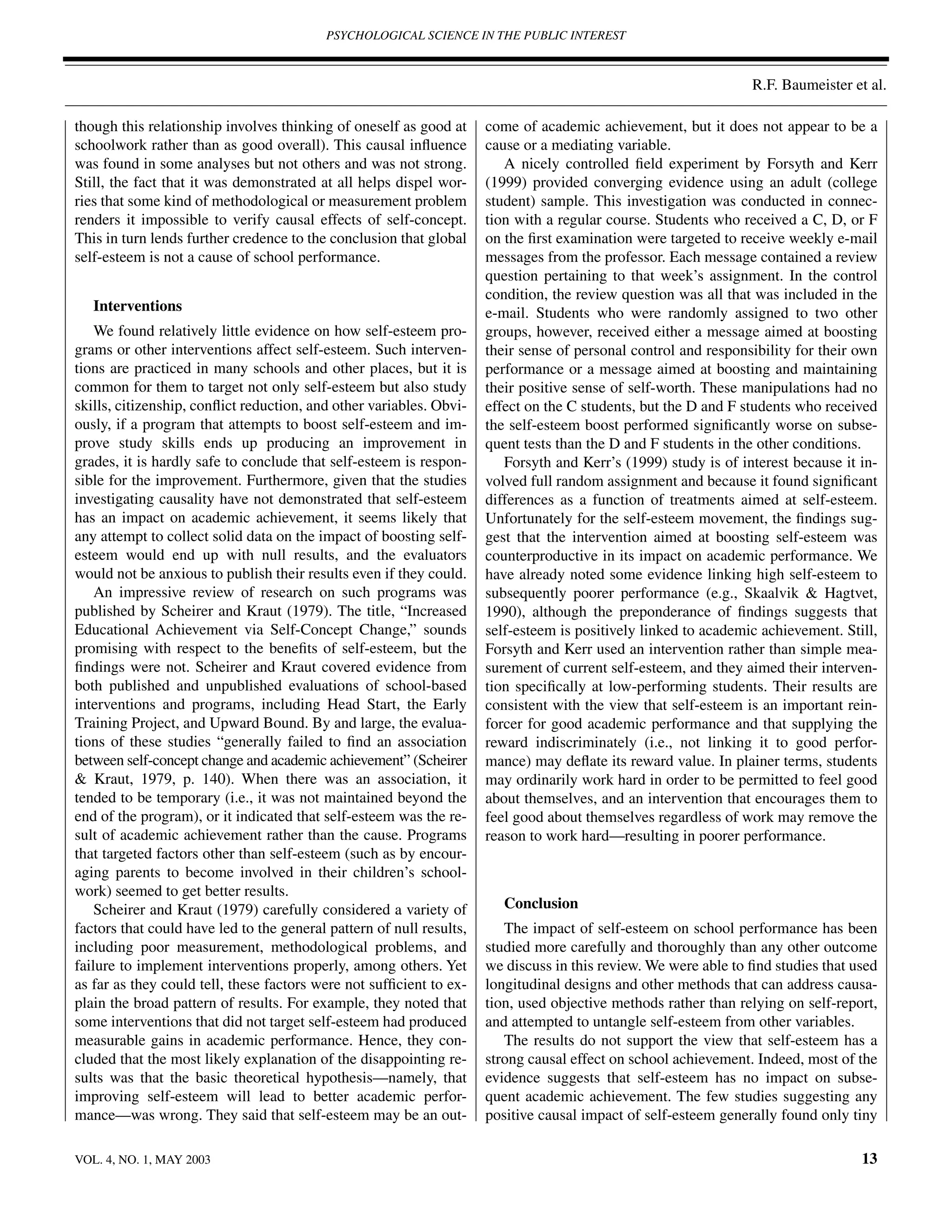
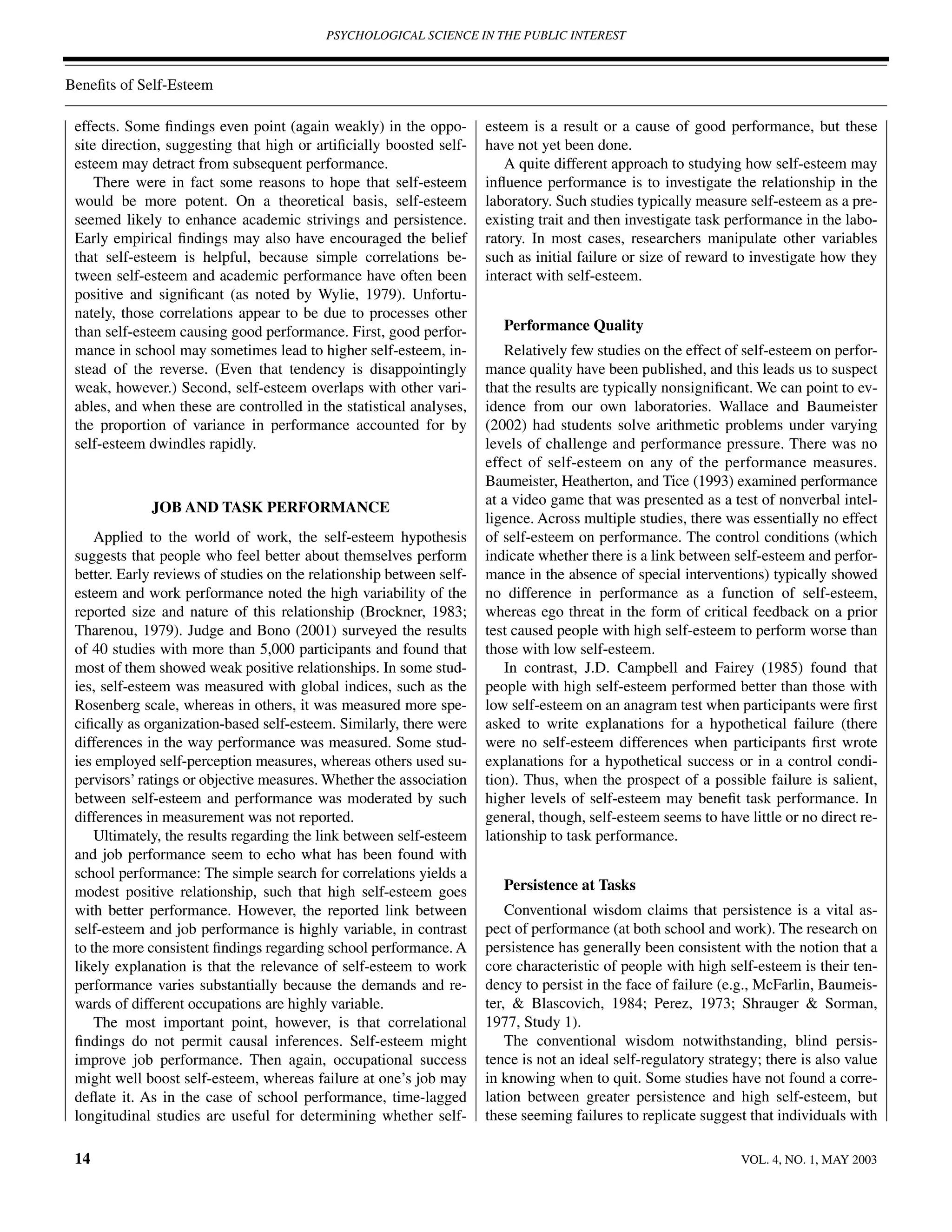
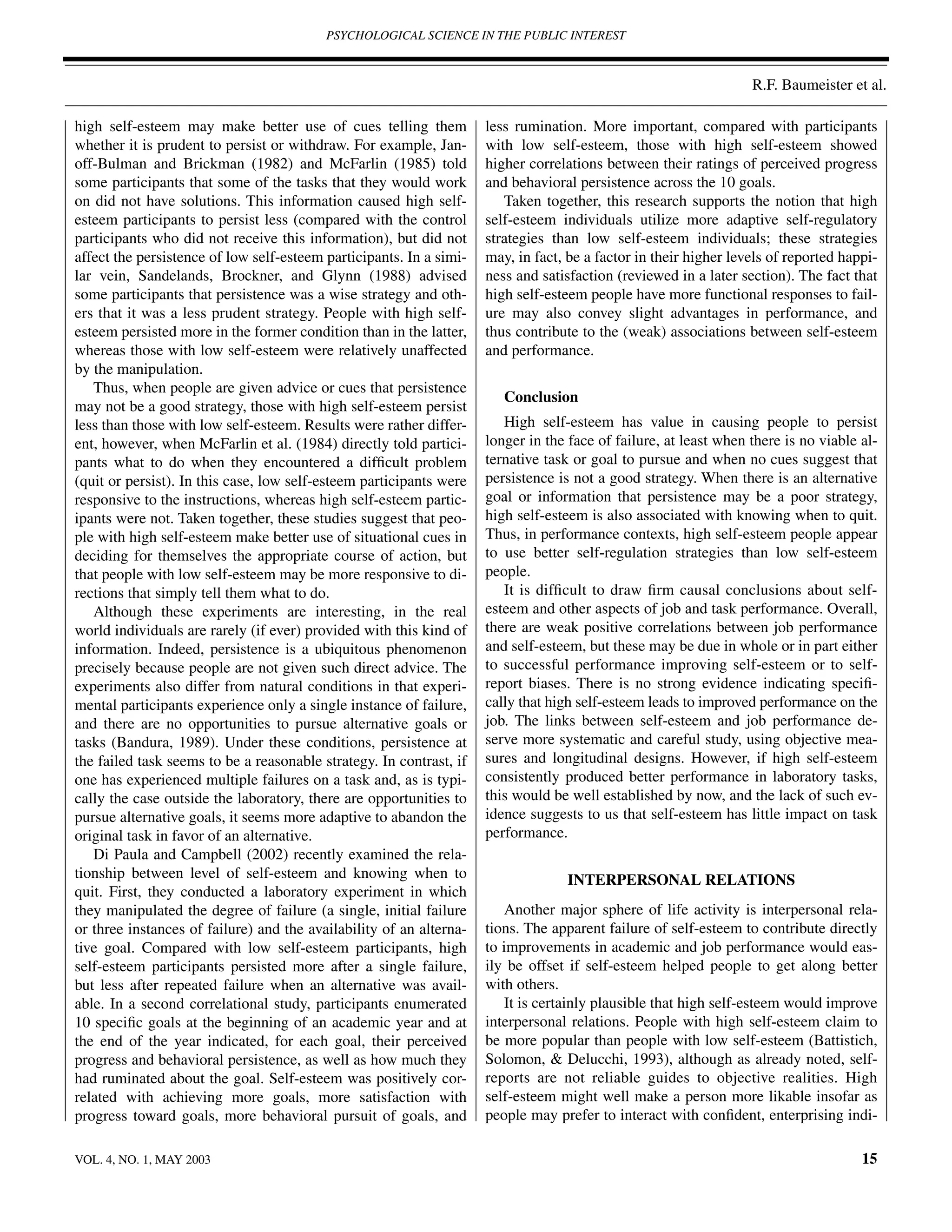
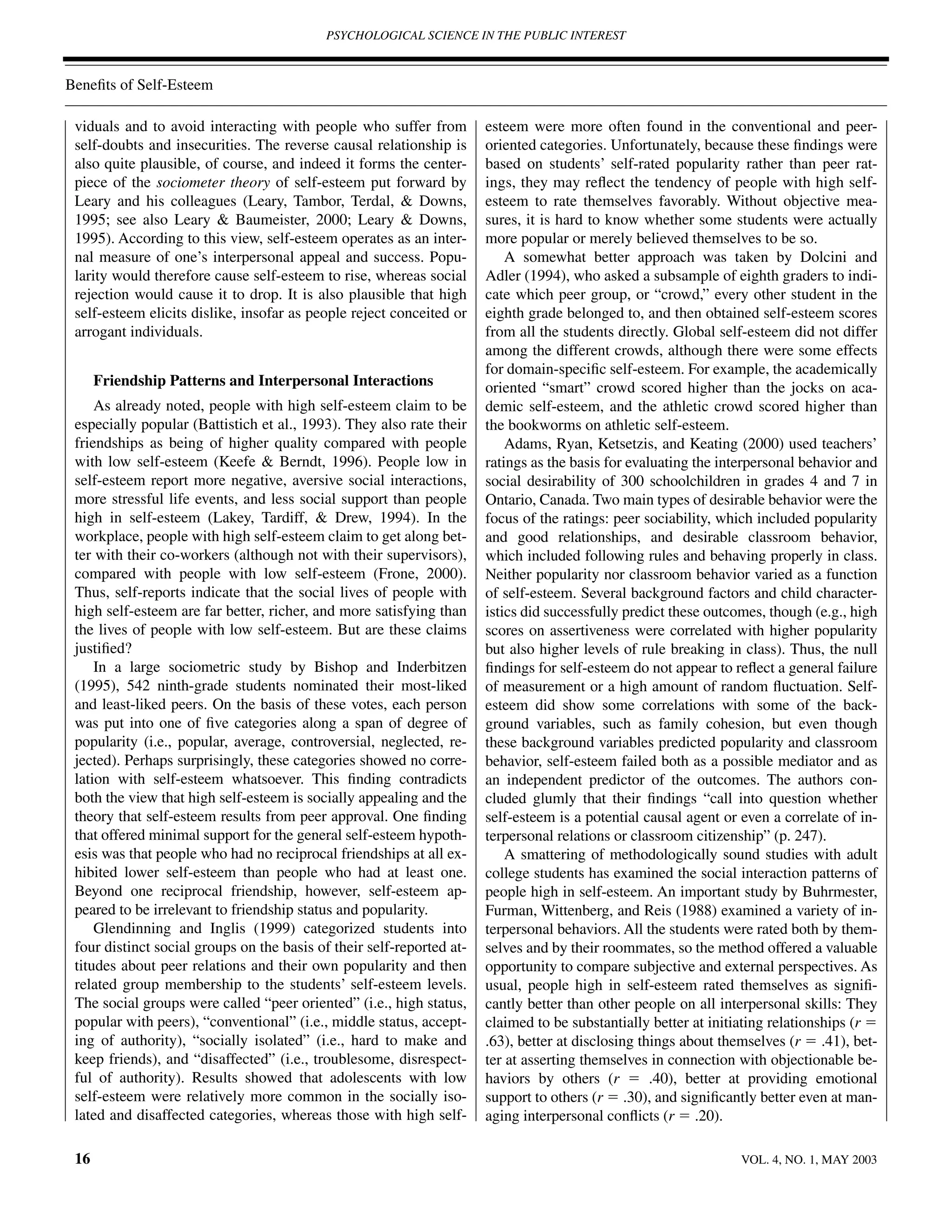
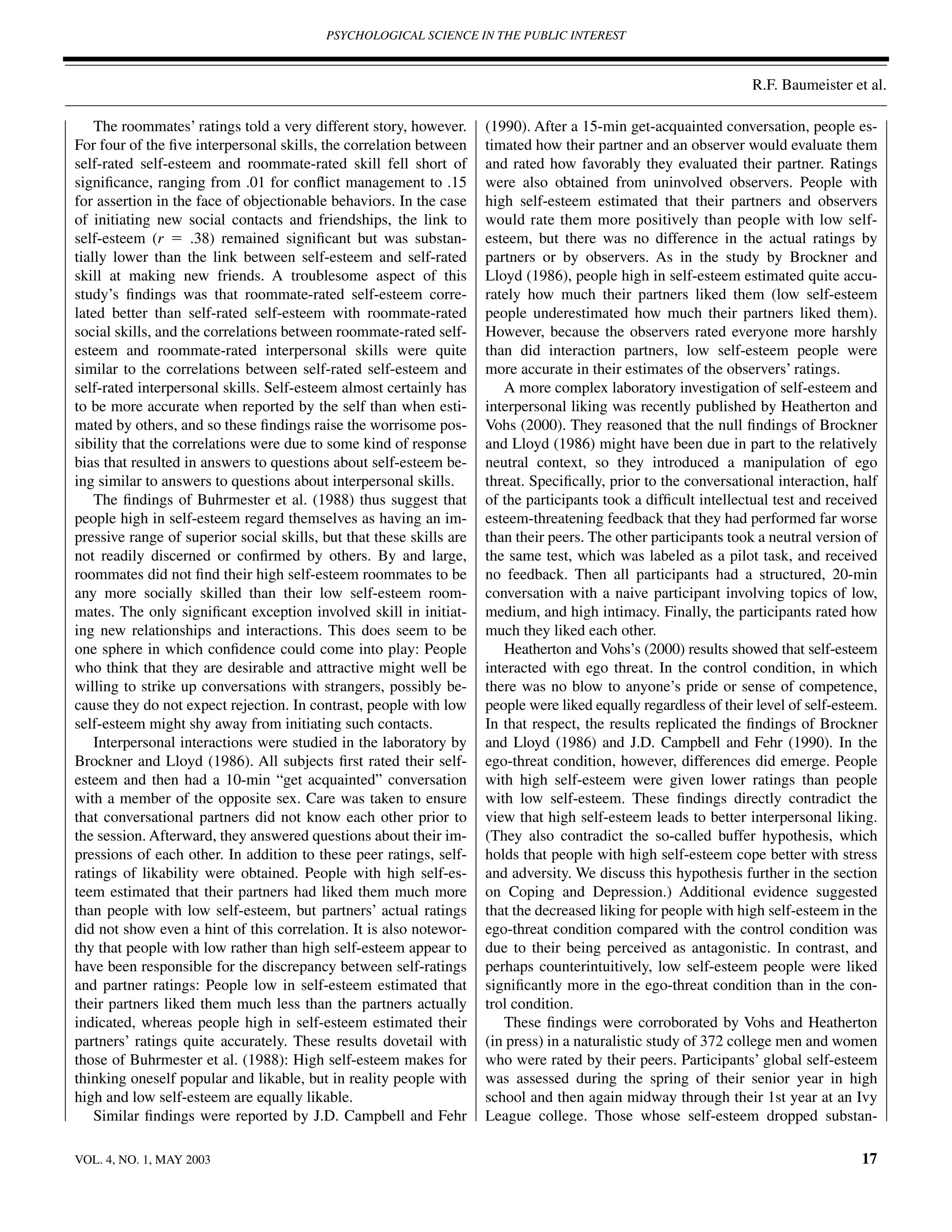
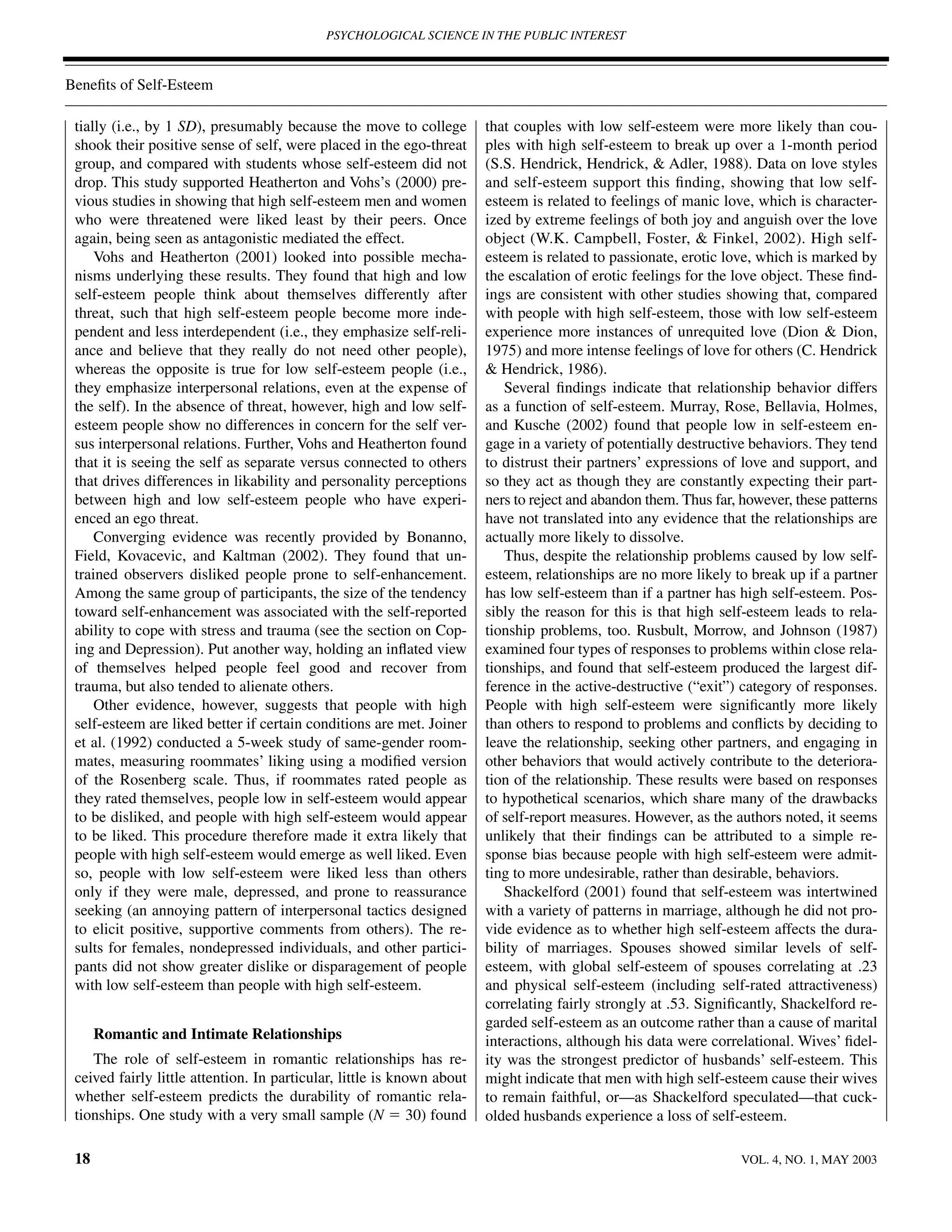

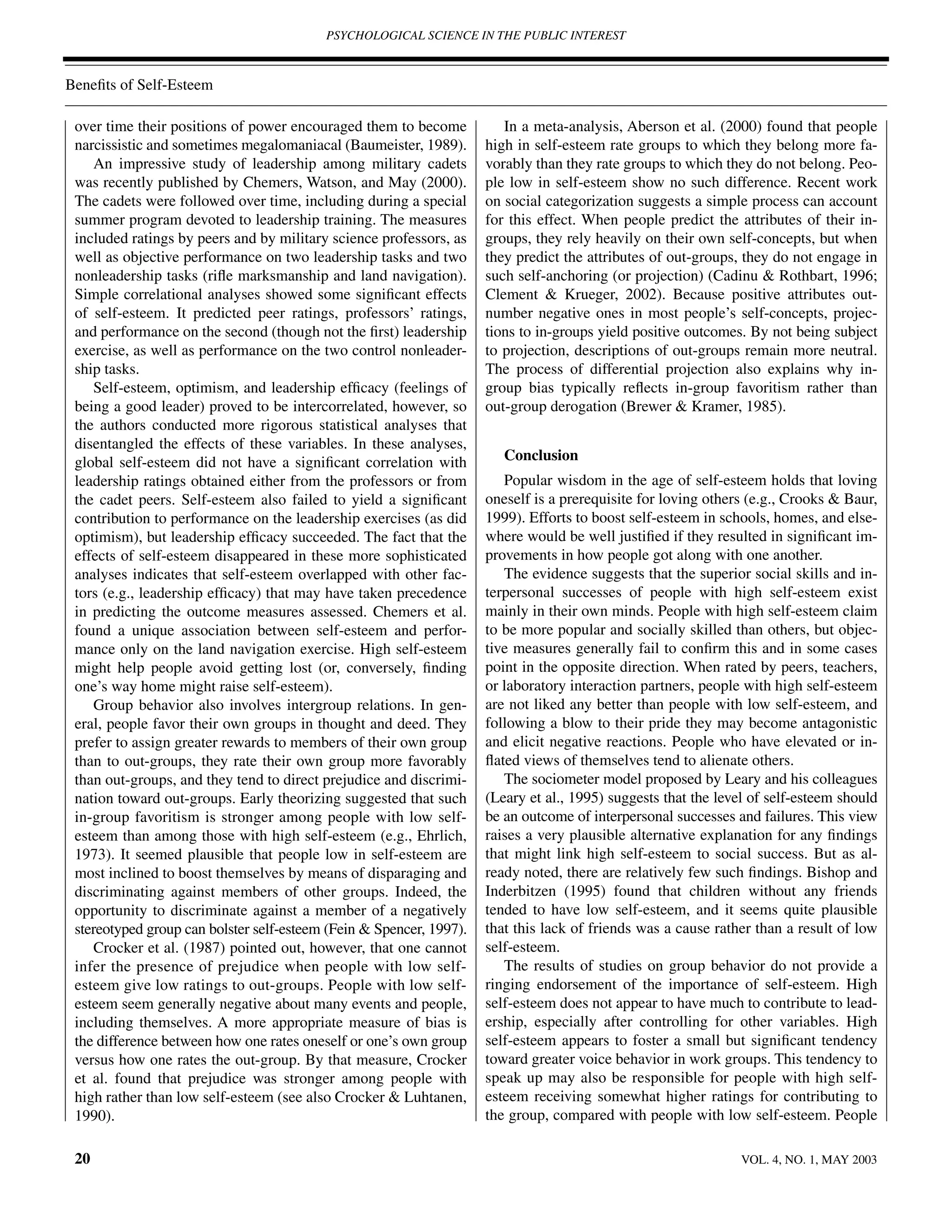
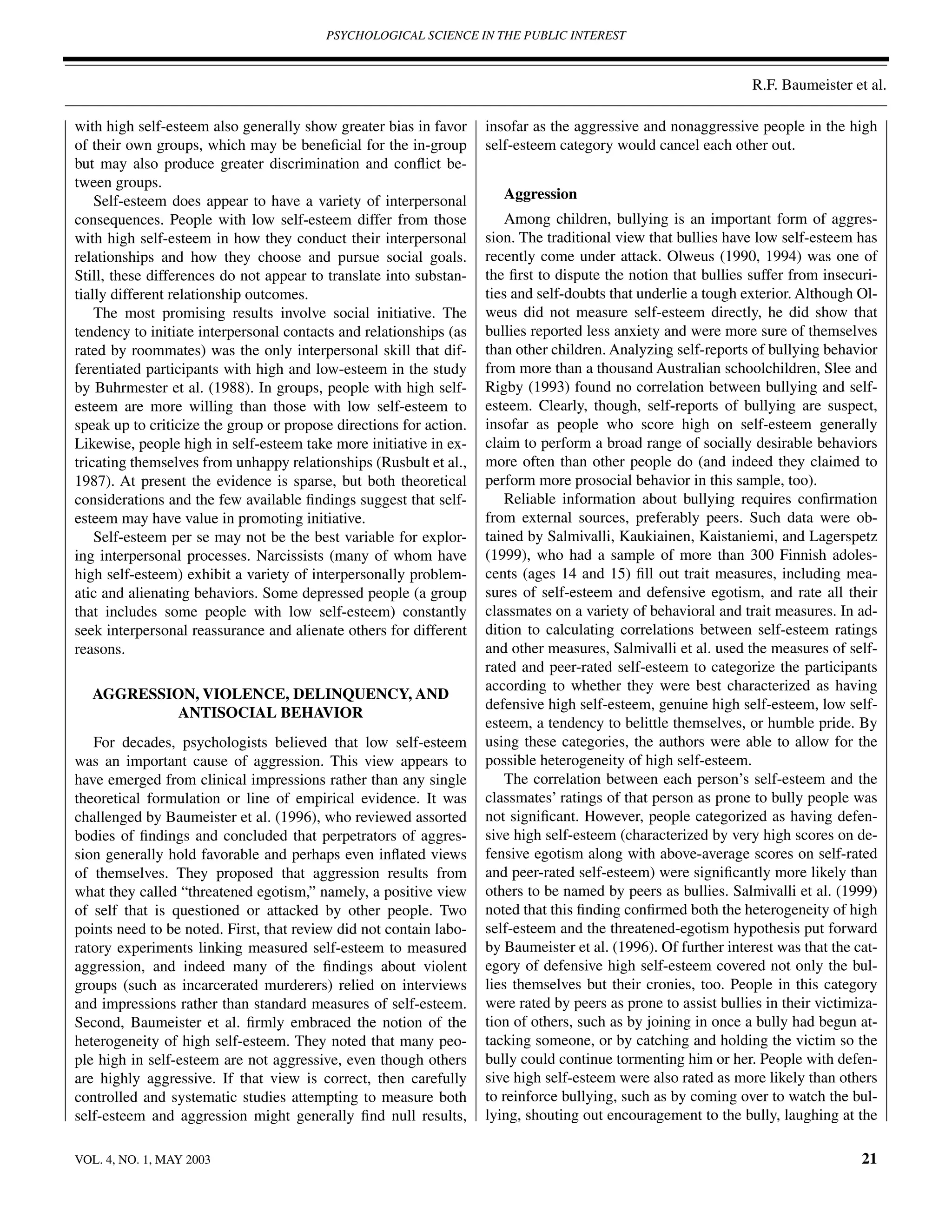
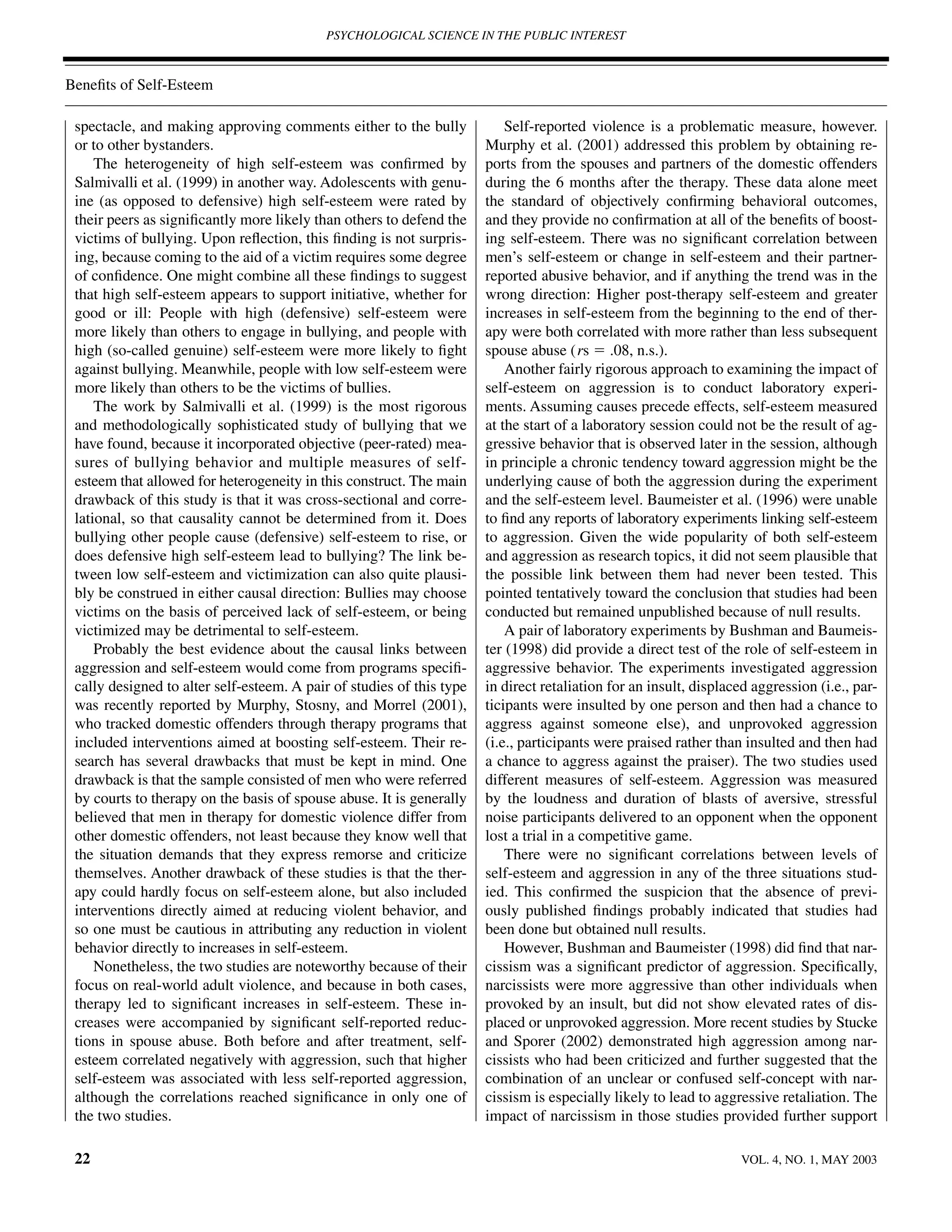
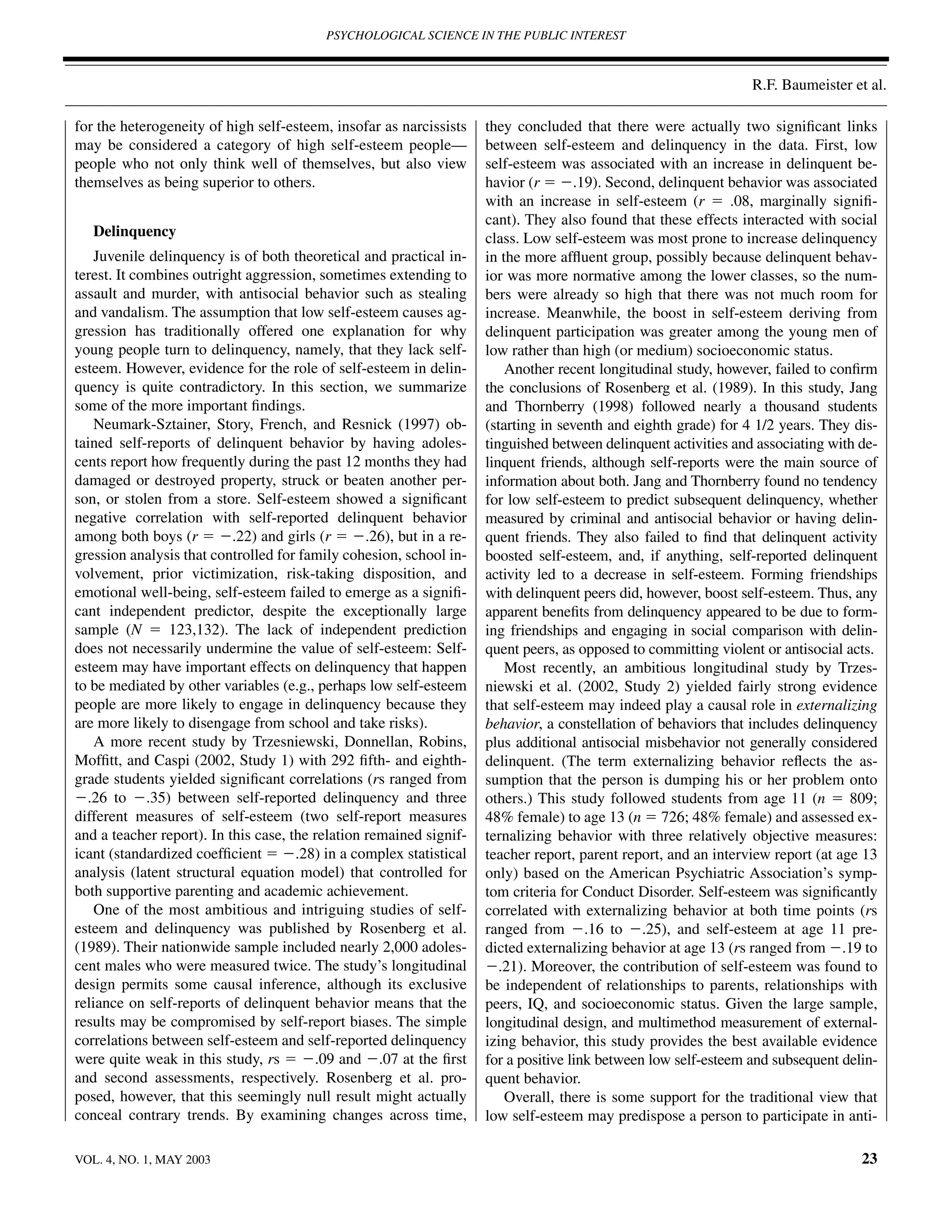
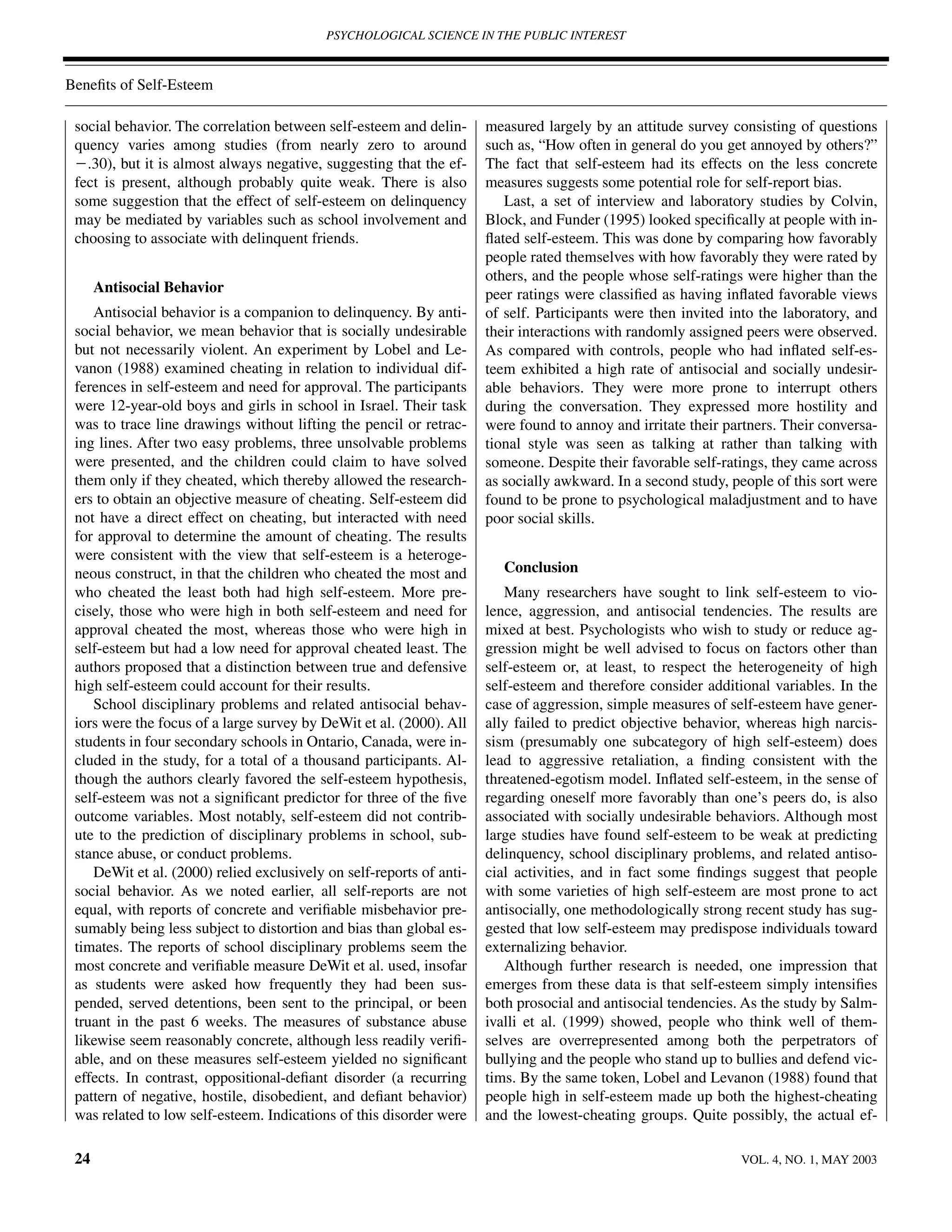
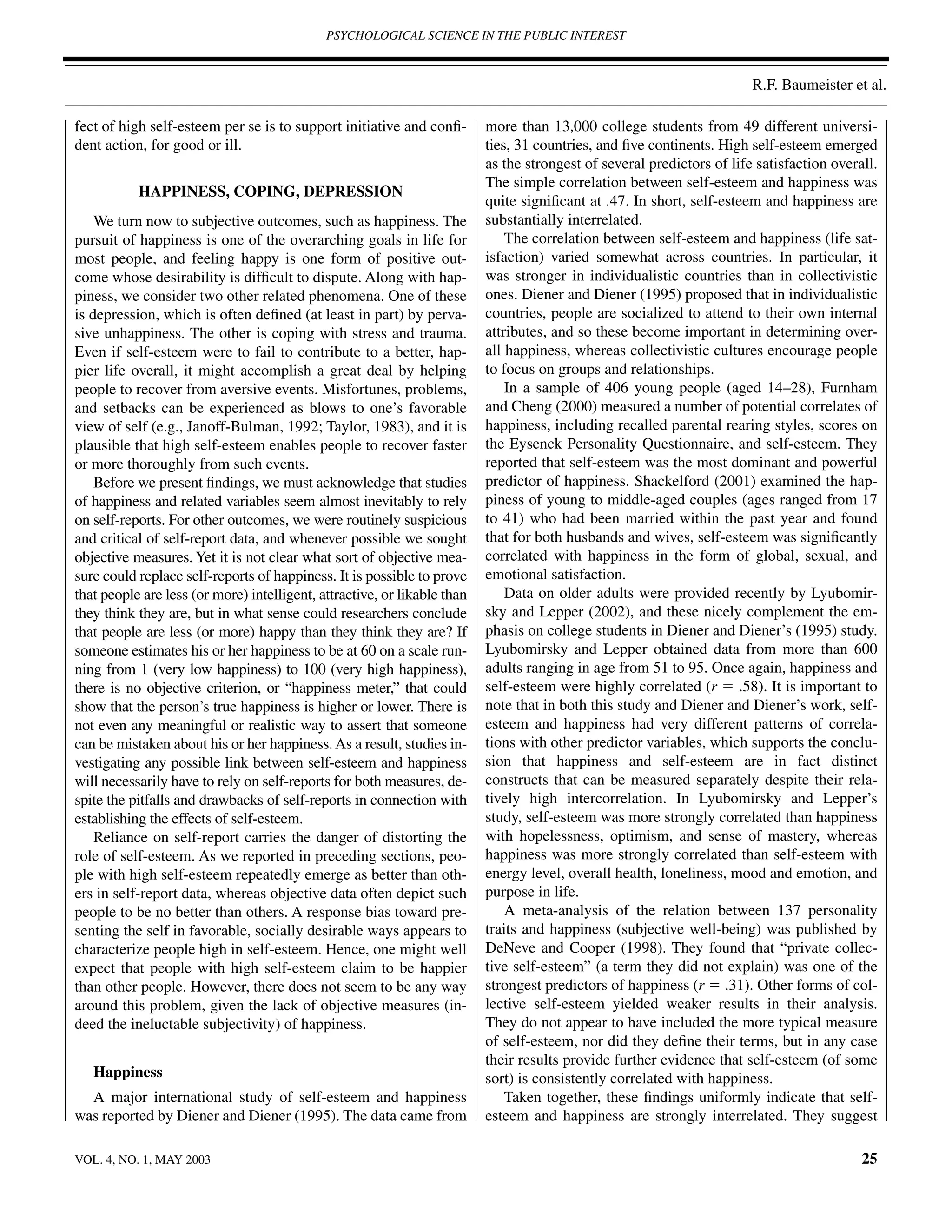
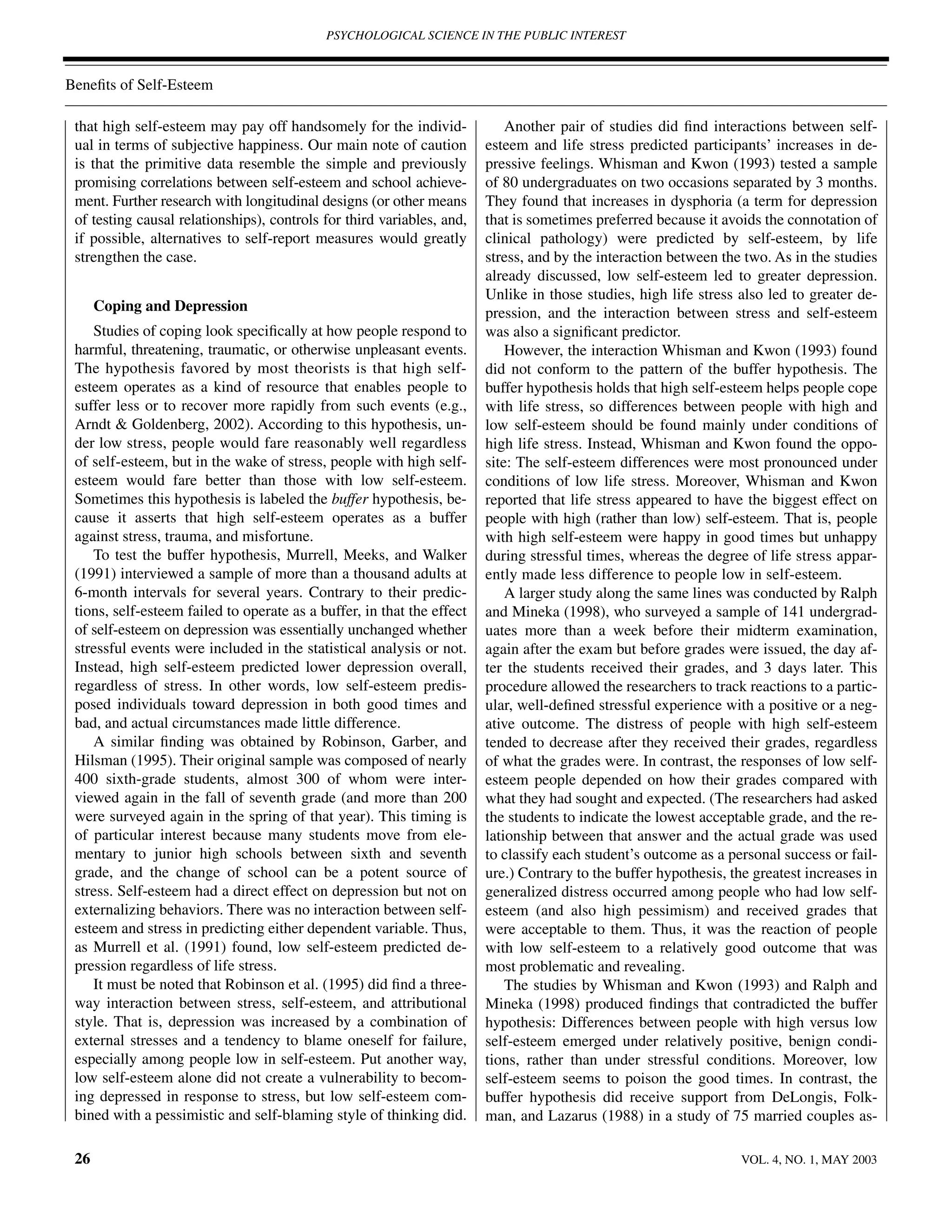
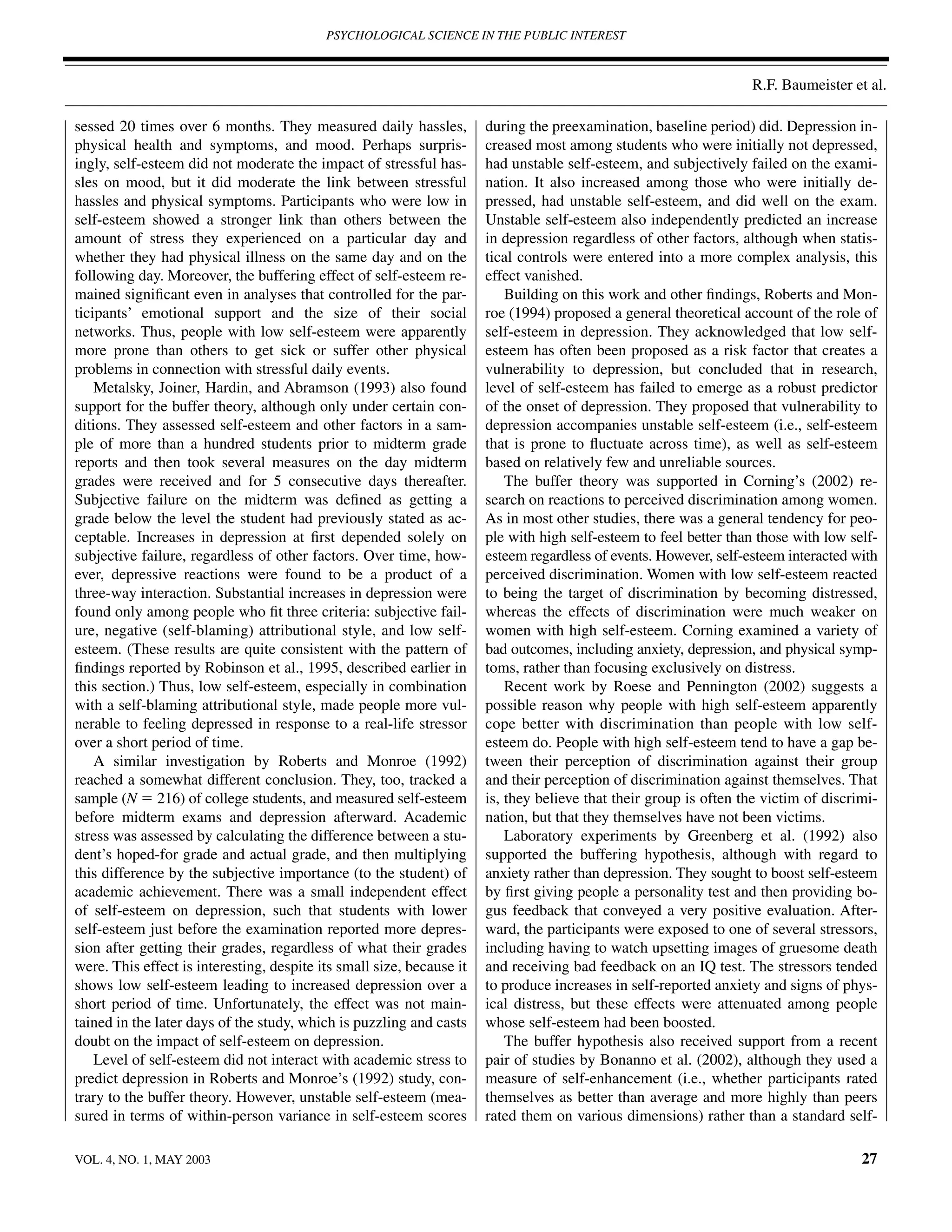
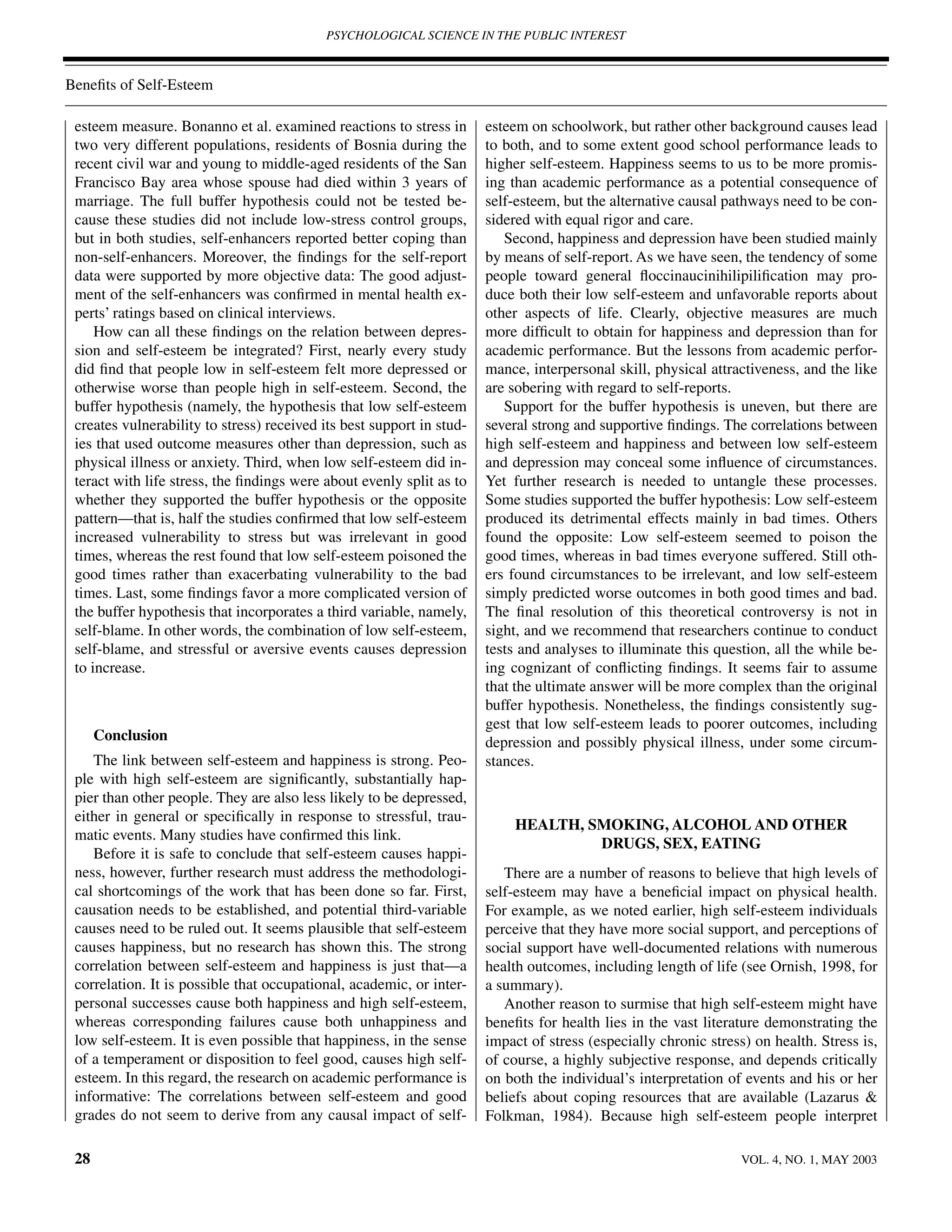
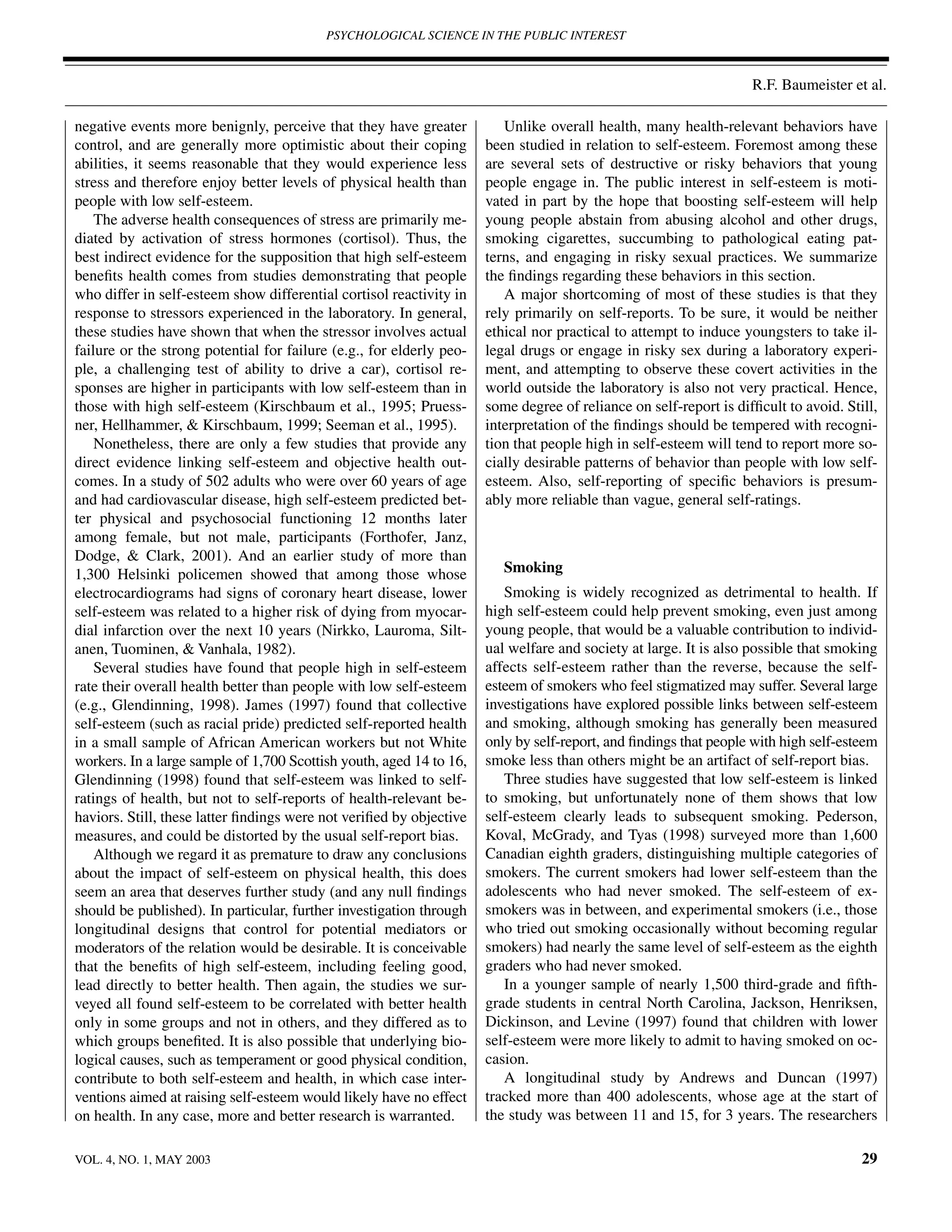
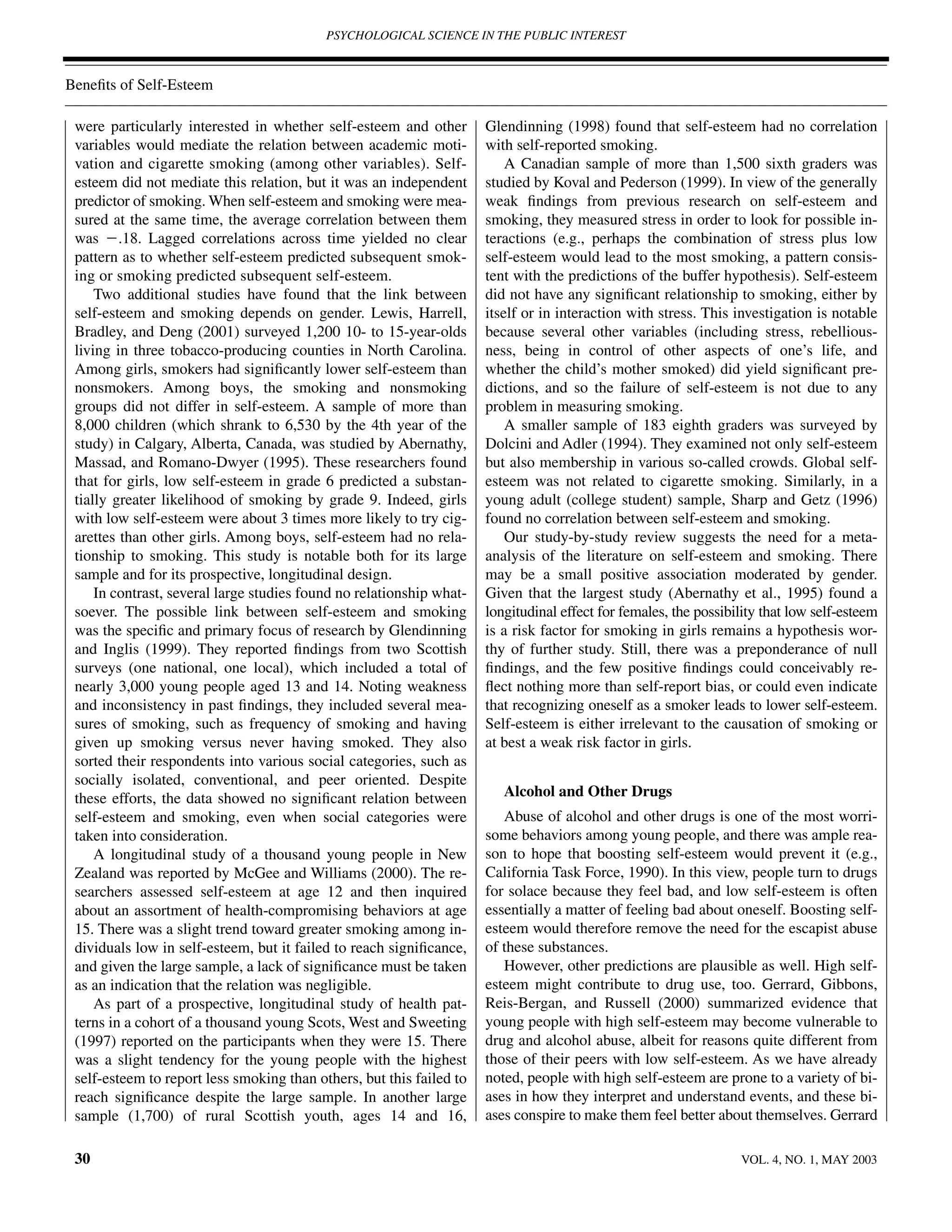
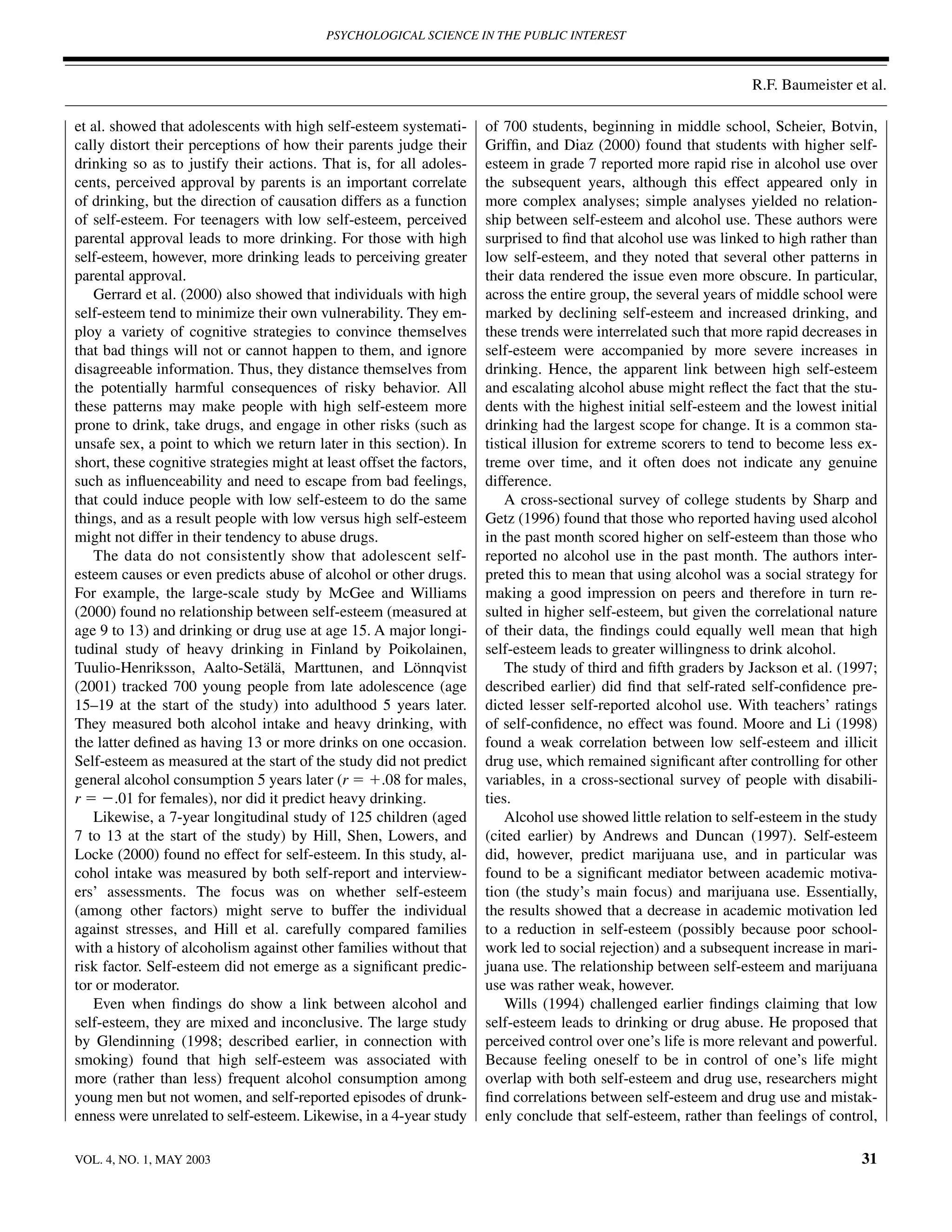
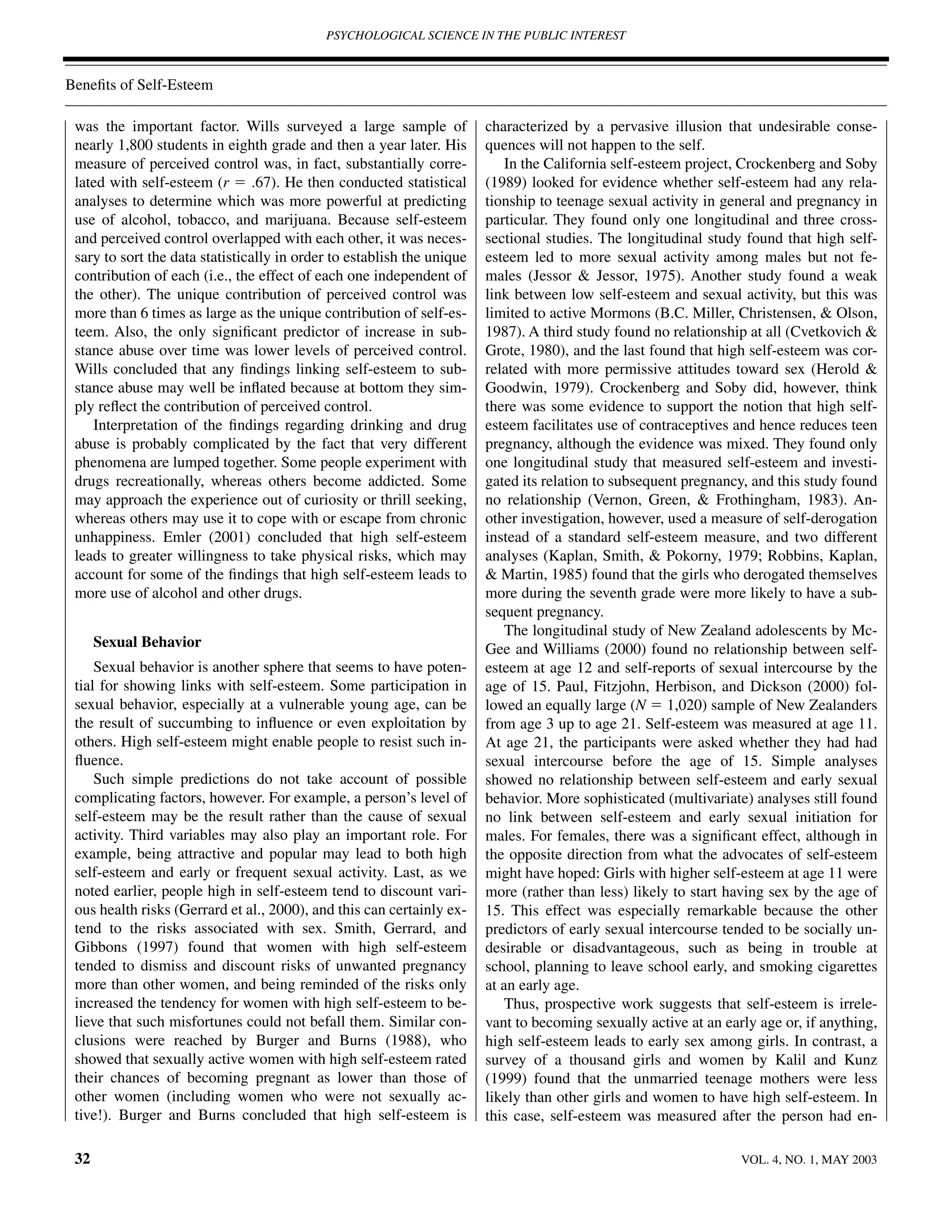
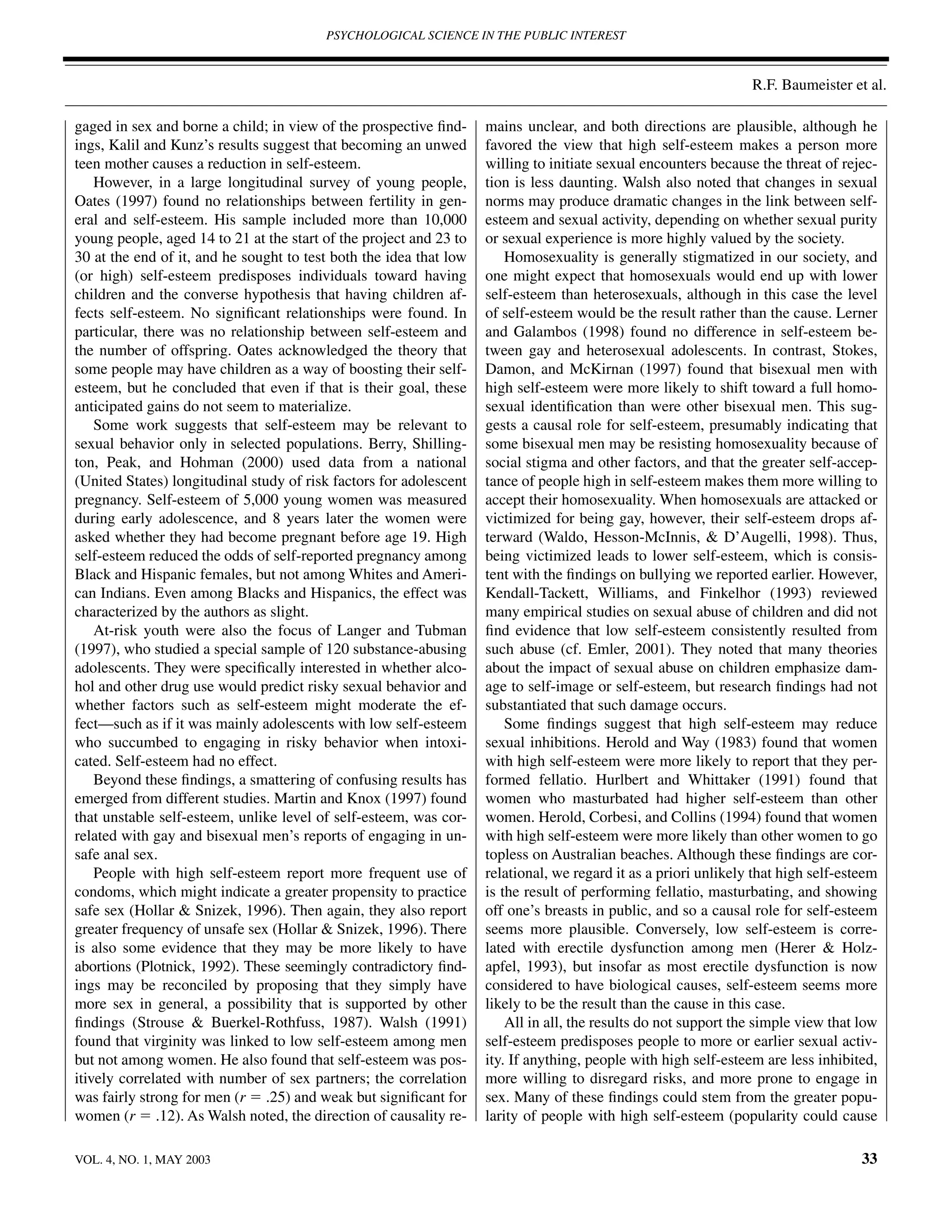
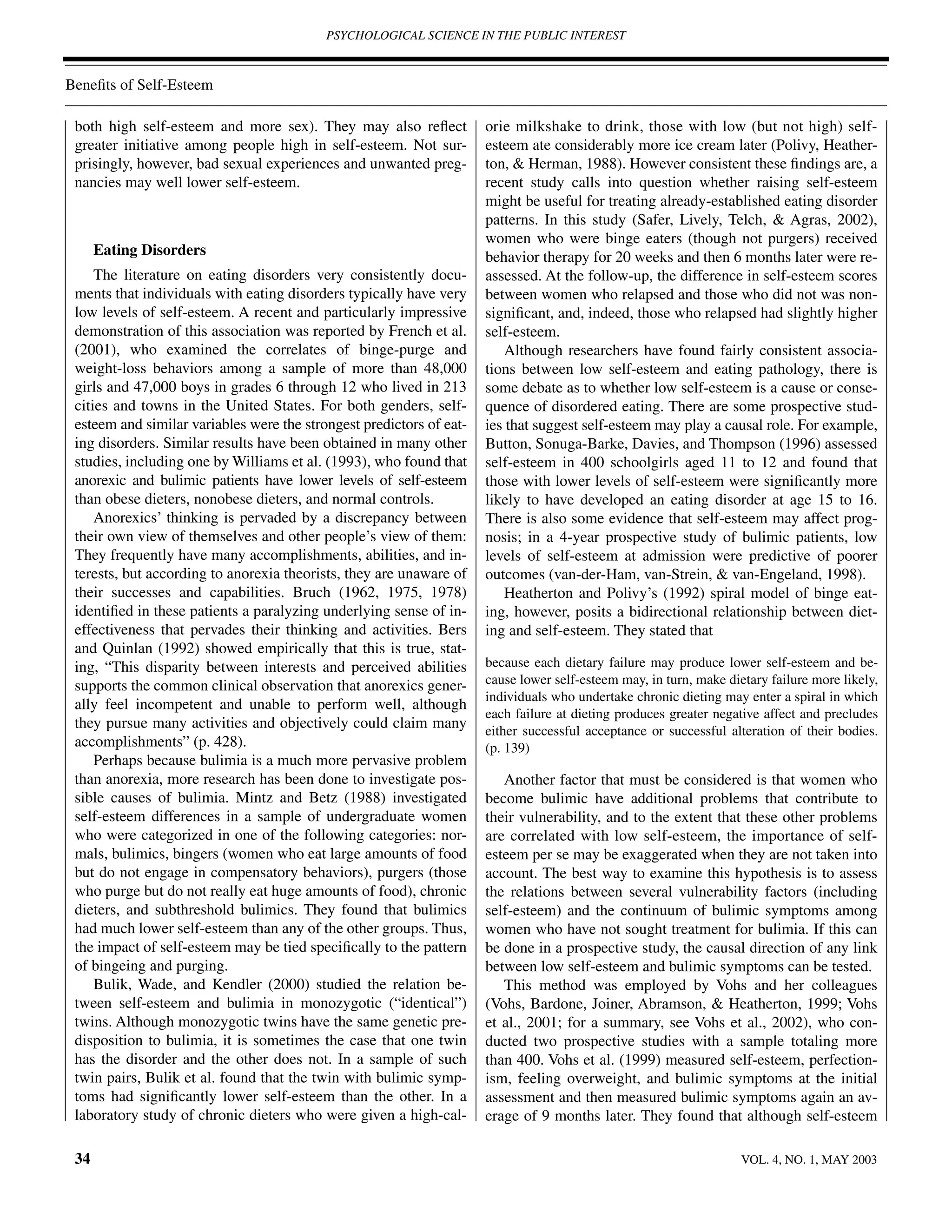
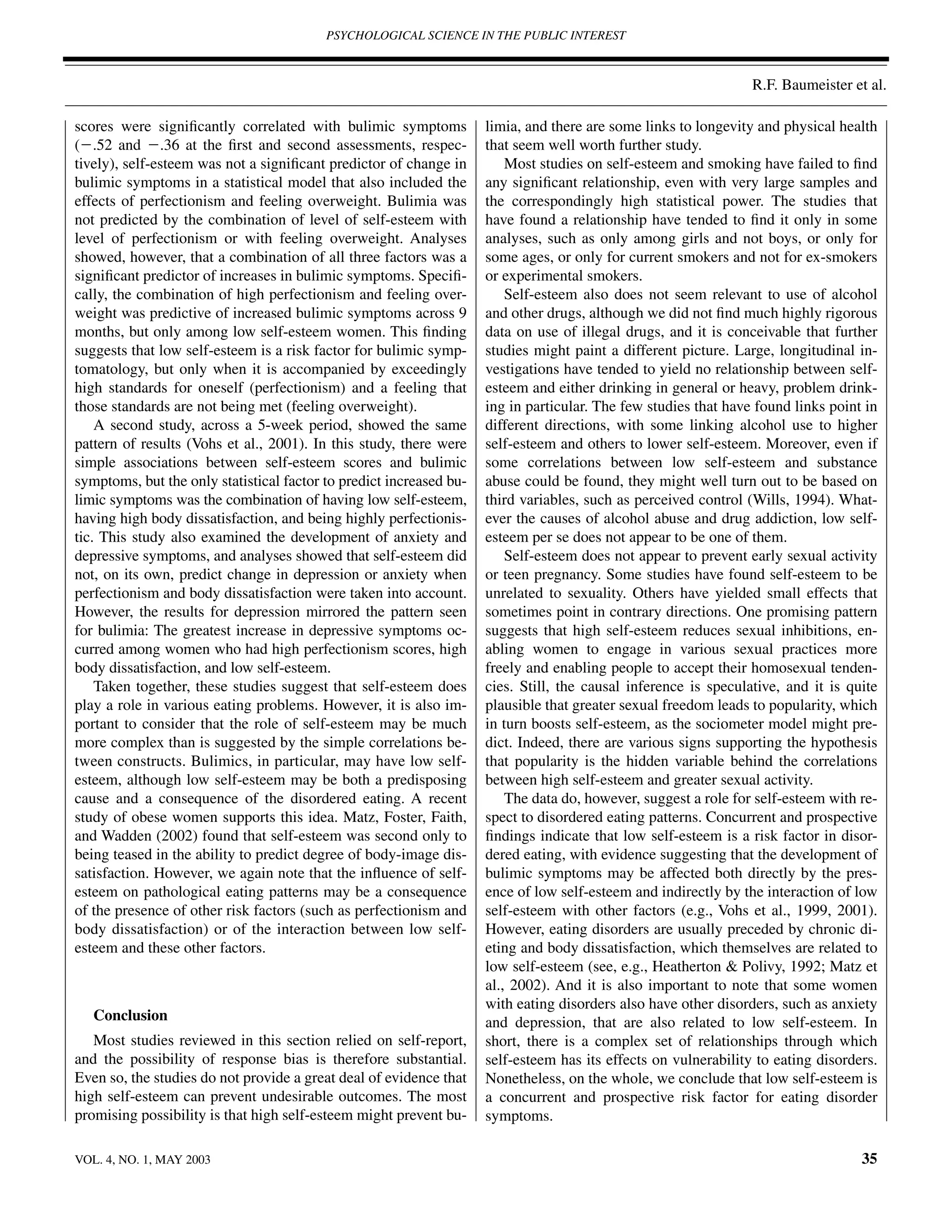
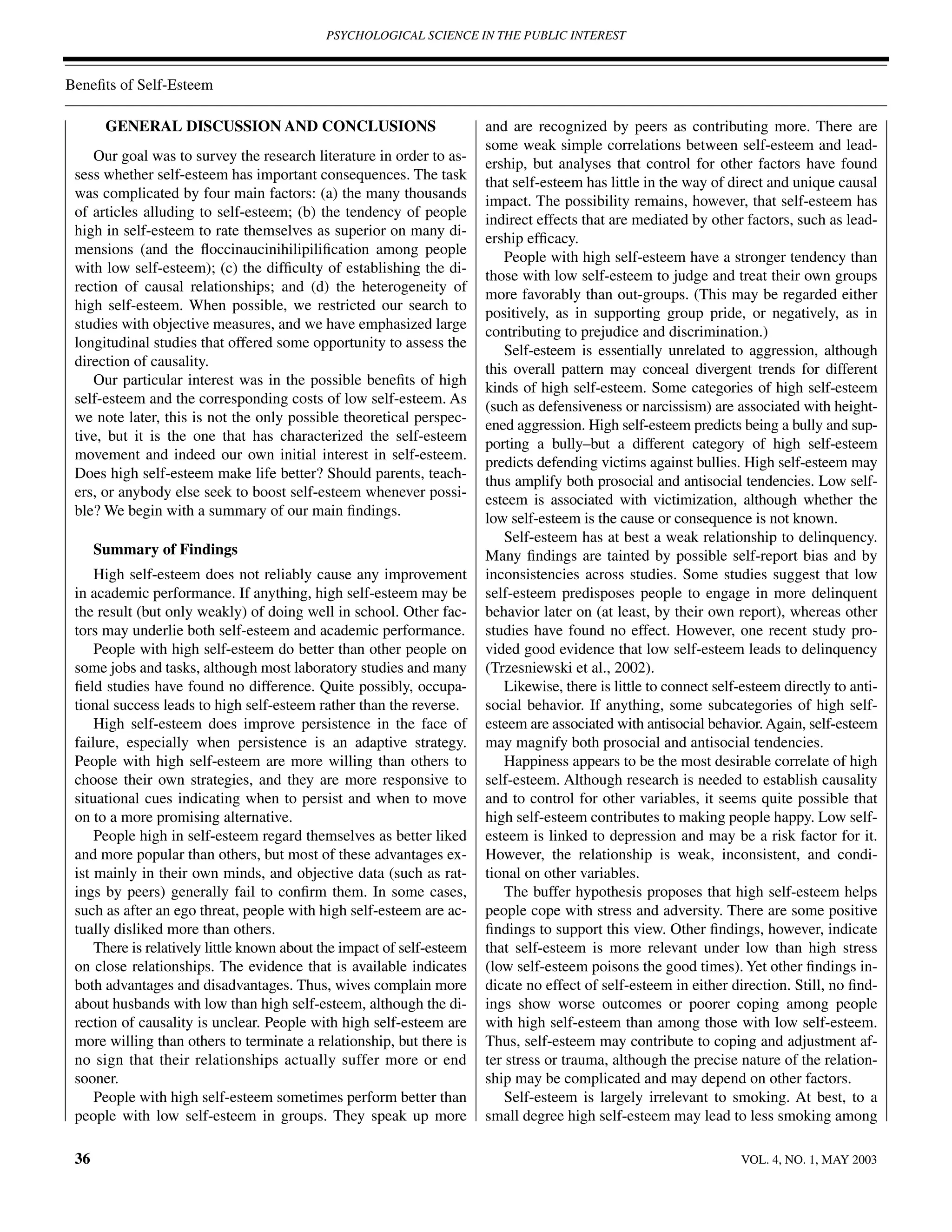
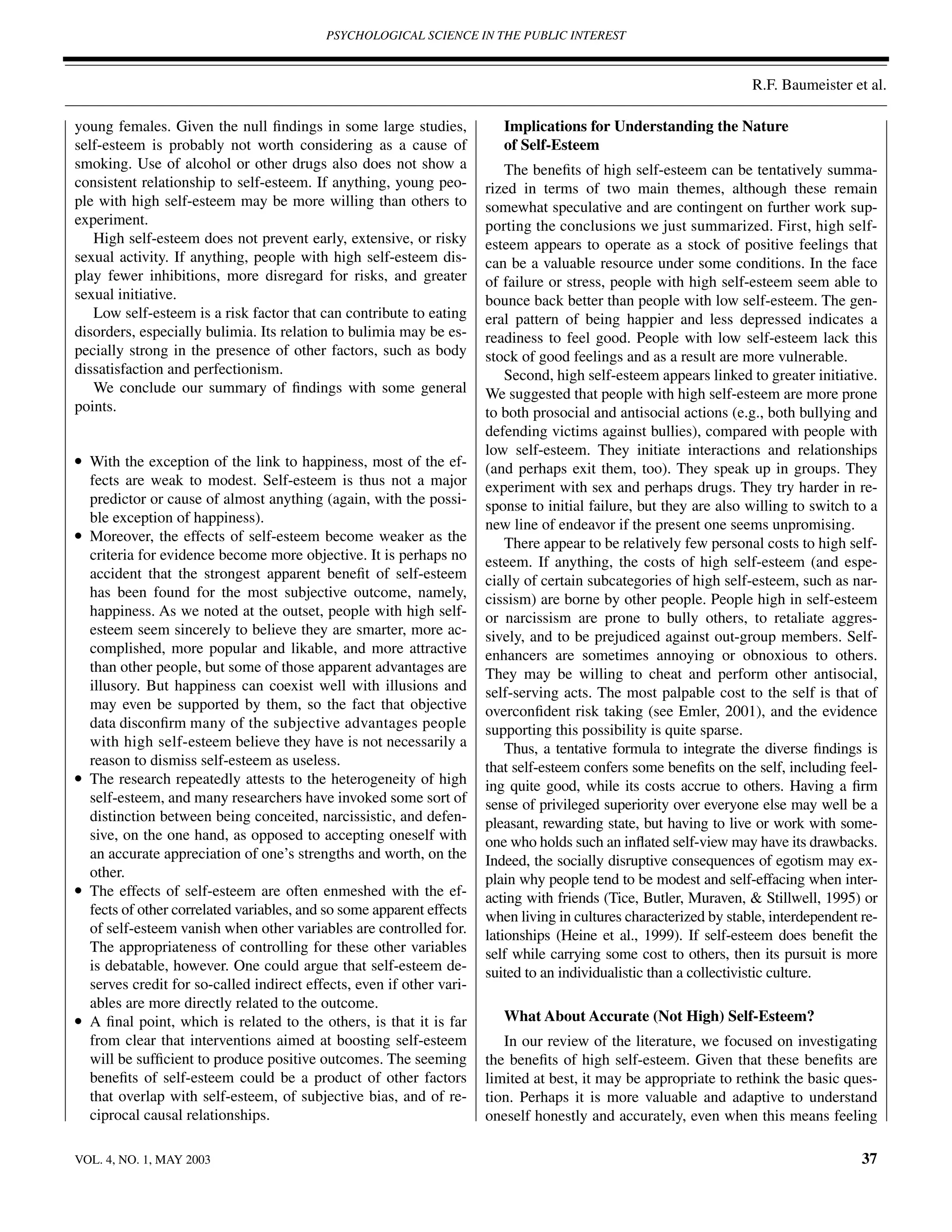
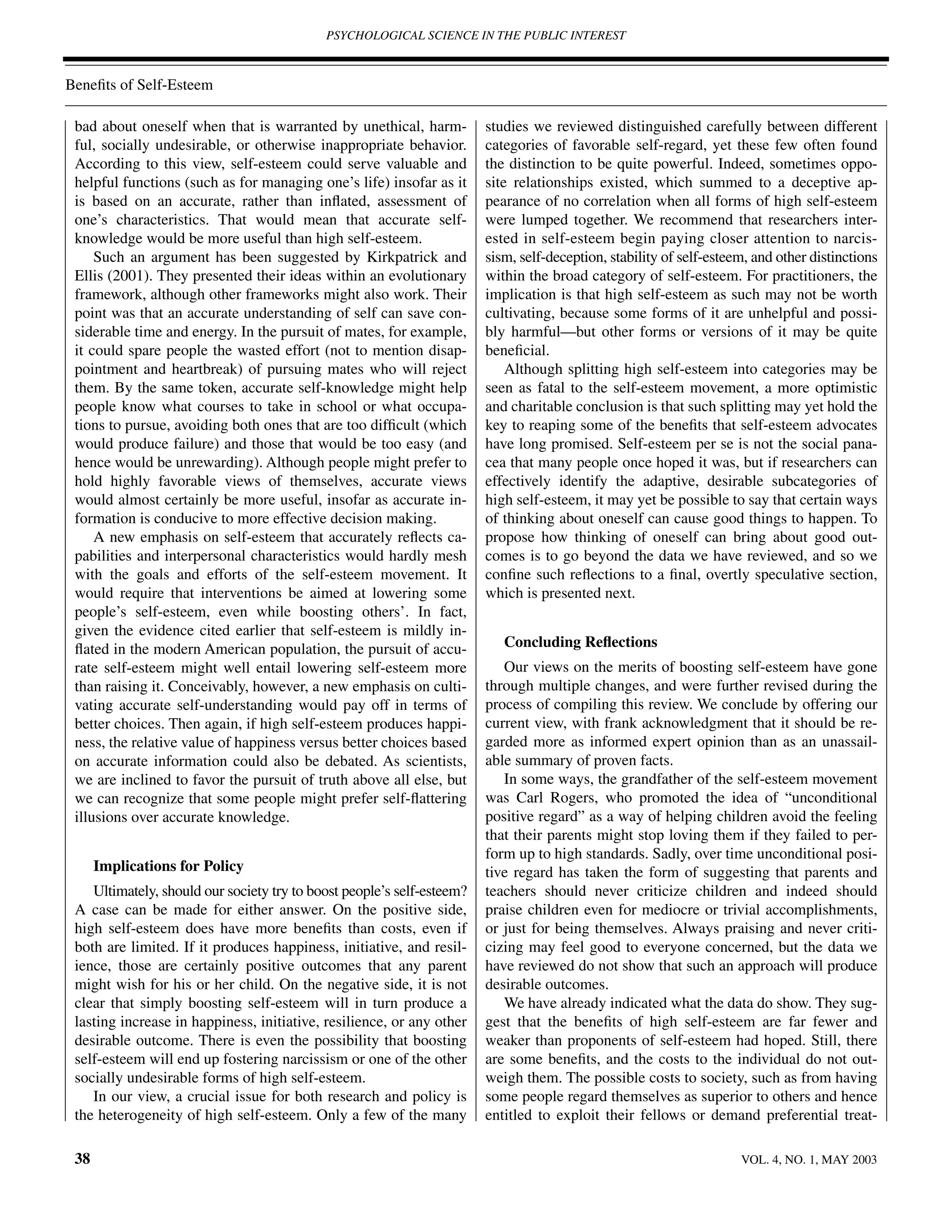
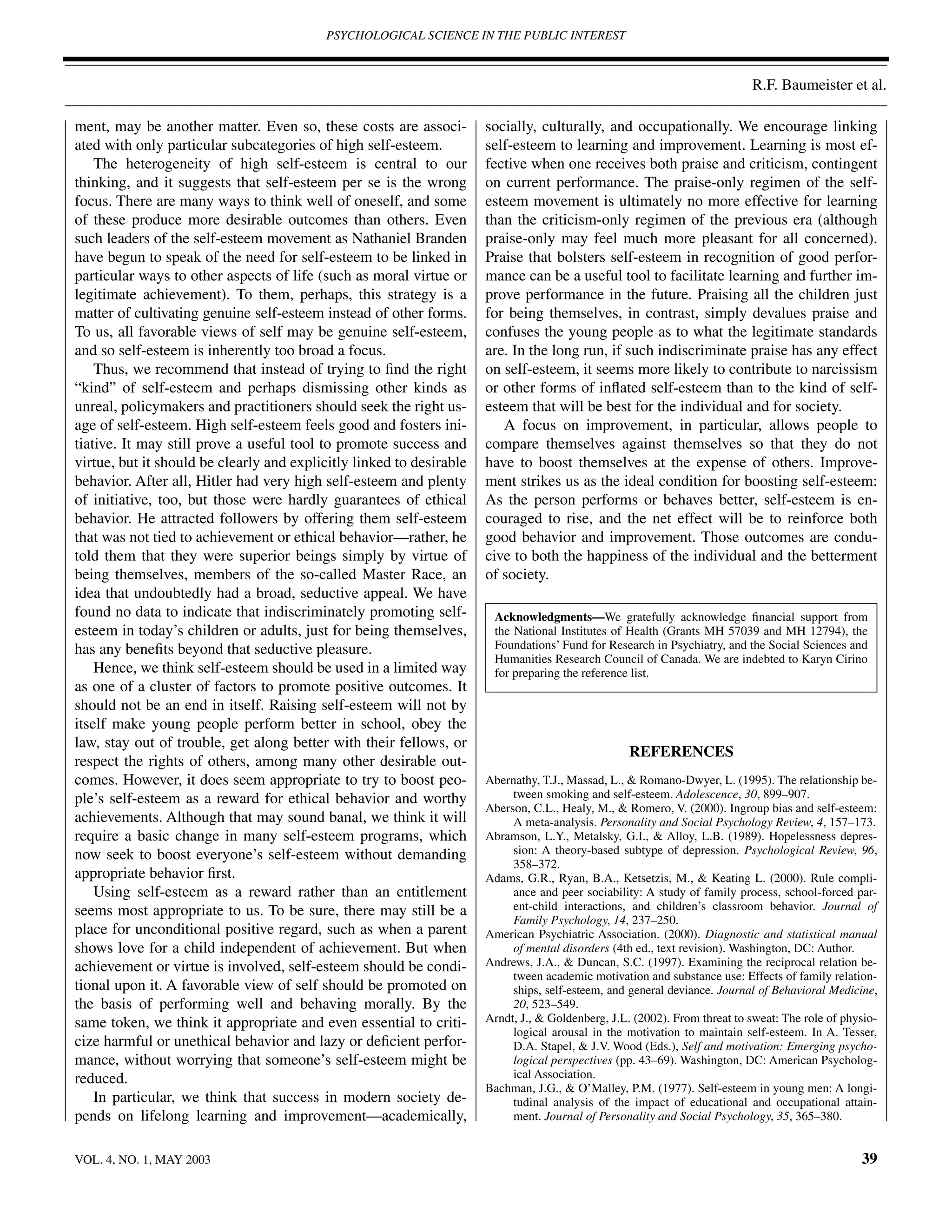
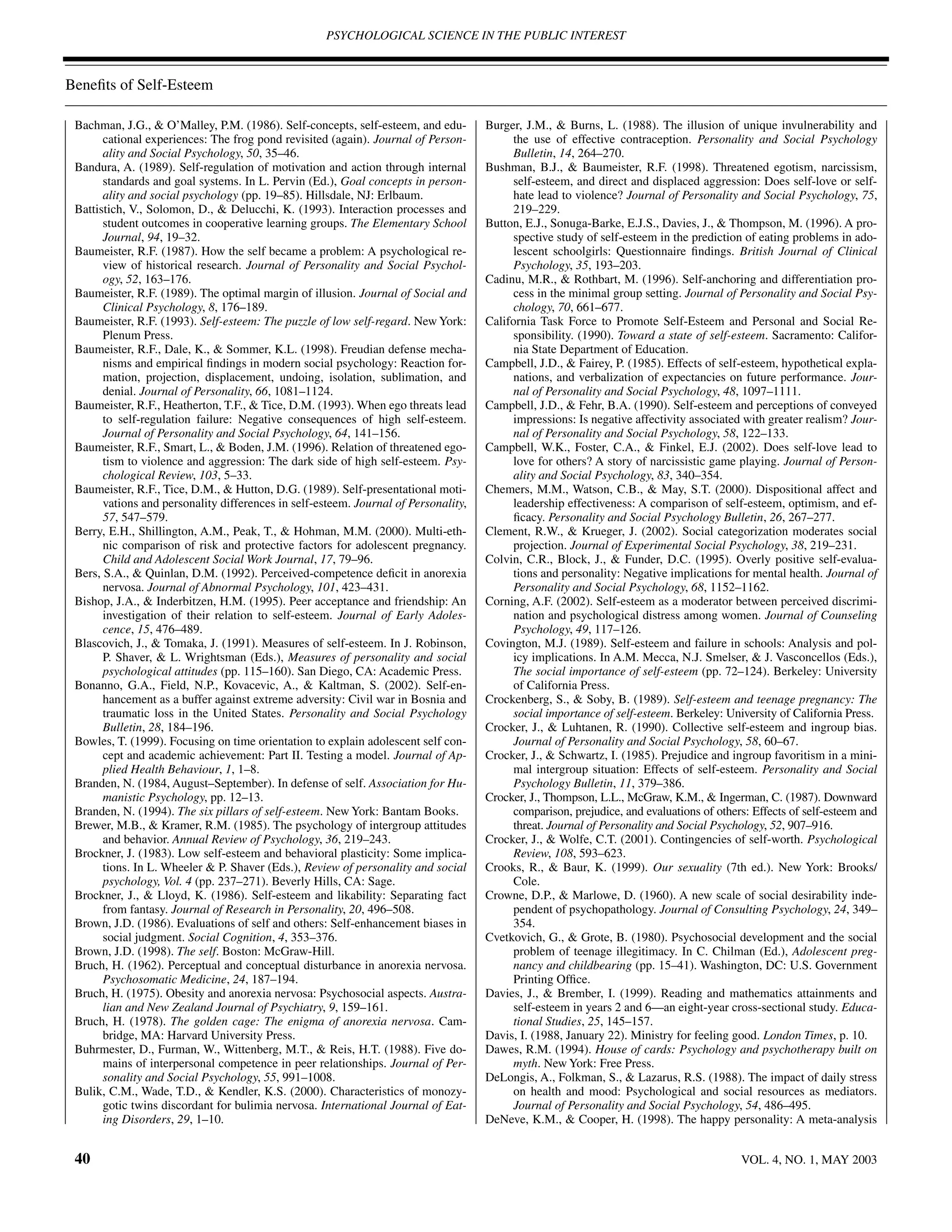

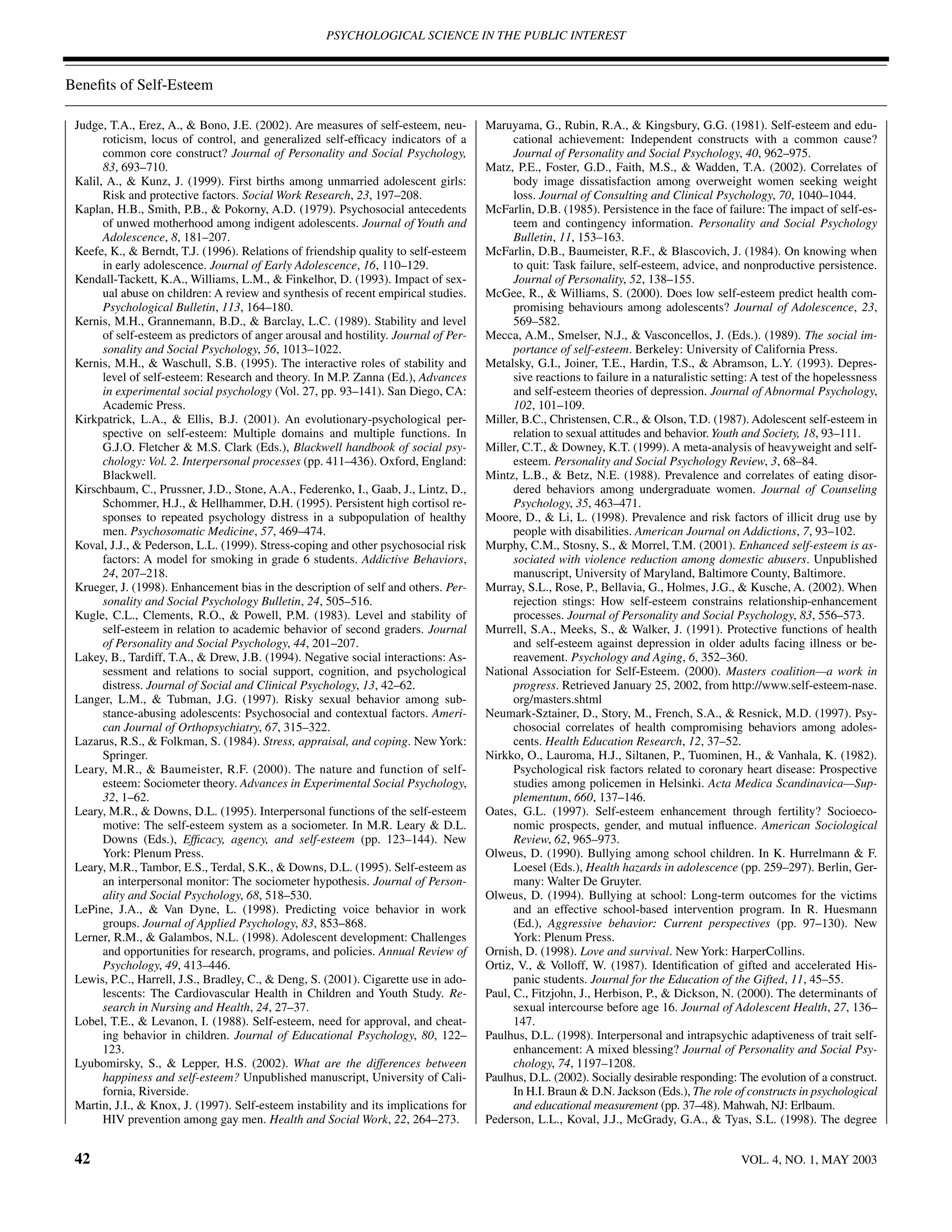
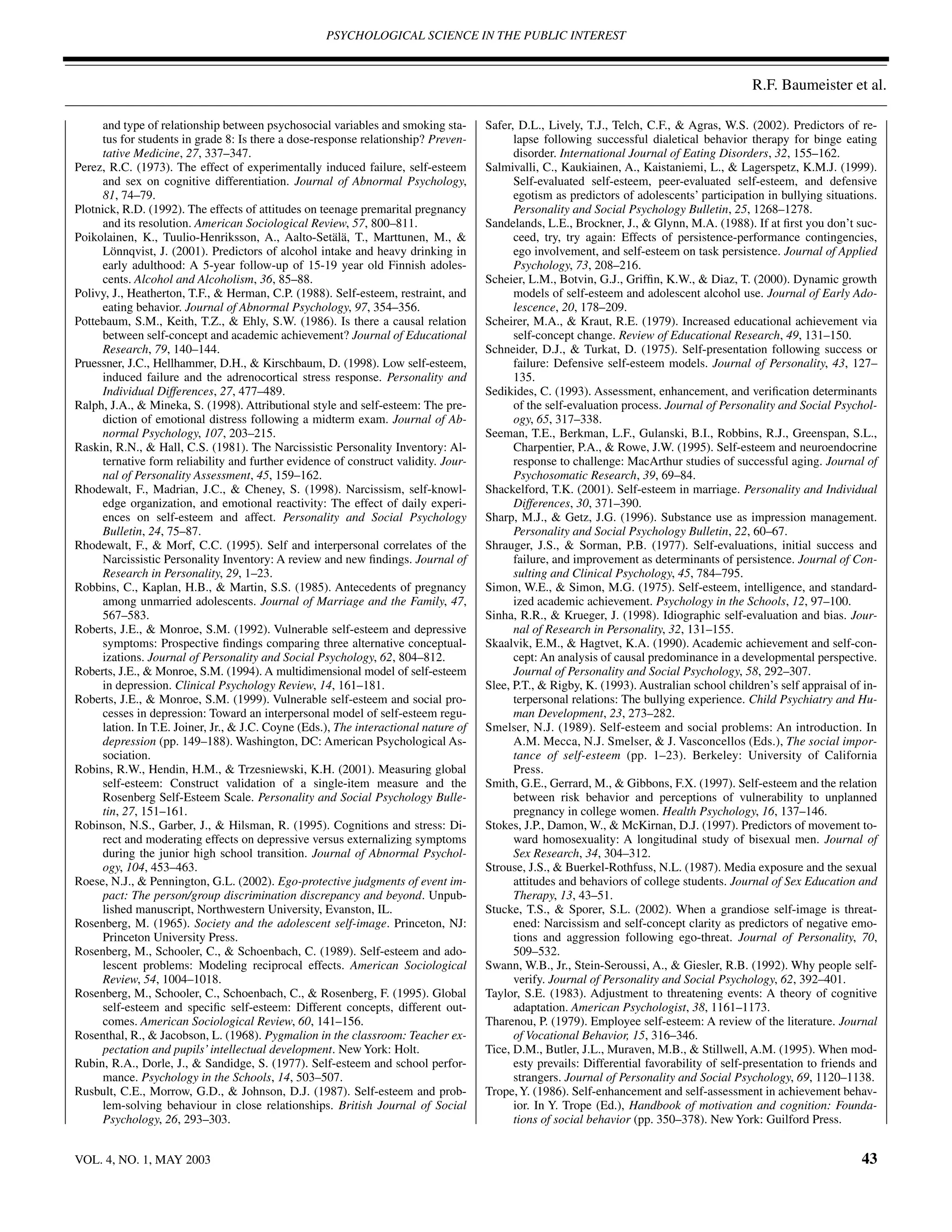
![PSYCHOLOGICAL SCIENCE IN THE PUBLIC INTEREST
Benefits of Self-Esteem
Trzesniewski, K.H., Donnellan, M.B., Robins, R.W., Moffitt, T.E., & Caspi, A. and consequences of victimization of lesbian, gay, and bisexual young
(2002, February). Do juvenile delinquents have high or low self-esteem? people: A structural model comparing rural university and urban sam-
Paper presented at the annual meeting of the Society for Personality and ples. American Journal of Community Psychology, 26, 307–334.
Social Psychology, Savannah, GA. Wallace, H.M., & Baumeister, R.F. (2002). The performance of narcissists
Twenge, J.M., & Campbell, W.K. (2001). Age and birth cohort differences in rises and falls with perceived opportunity for glory. Journal of Personal-
self-esteem: A cross-temporal meta-analysis. Personality and Social Psy- ity and Social Psychology, 82, 819–834.
chology Review, 5, 321–344. Walsh, A. (1991). Self-esteem and sexual behavior: Exploring gender differ-
van-der-Ham, T., van-Strein, D.C., & van-Engeland, H. (1998). Personality ences. Sex Roles, 25, 441–450.
characteristics predict outcomes of eating disorders in adolescents: A 4-year West, P., & Sweeting, H. (1997). “Lost souls” and “rebels”: A challenge to the
prospective study. European Child and Adolescent Psychiatry, 7, 79–84. assumption that low self-esteem and unhealthy lifestyles are related.
Vernon, M.E.L., Green, J.A., & Frothingham, T.E. (1983). Teenage pregnancy: Health Education, 5, 161–167.
A prospective study of self-esteem and other sociodemographic factors. Whisman, M.A., & Kwon, P. (1993). Life stress and dysphoria: The role of
Pediatrics, 72, 632–635. self-esteem and hopelessness. Journal of Personality and Social Psychol-
Vohs, K.D., Bardone, A.M., Joiner, T.E., Jr., Abramson, L.Y., & Heatherton, ogy, 65, 1054–1060.
T.F. (1999). Perfectionism, perceived weight status, and self-esteem in- Williams, G.J., Power, K.G., Millar, H.R., Freeman, C.P., Yellowlees, A.,
teract to predict bulimic symptoms: A model of bulimic symptom devel- Dowds, T., Walker, M., Campsie, L., MacPherson, F., & Jackson, M.A.
opment. Journal of Abnormal Psychology, 108, 695–700. (1993). Comparison of eating disorders and other dietary/weight
Vohs, K.D., & Heatherton, T.F. (2001). Self-esteem and threats to self: Impli- groups on measures of perceived control, assertiveness, self-esteem, and
cations for self-construals and interpersonal perceptions. Journal of Per- self-directed hostility. International Journal of Eating Disorders, 14,
sonality and Social Psychology, 81, 1103–1118. 27–32.
Vohs, K.D., & Heatherton, T.F. (in press). The effects of self-esteem and ego Wills, T.A. (1981). Downward comparison principles in social psychology.
threat on interpersonal appraisals of men and women: A naturalistic Psychological Bulletin, 90, 245–271.
study. Personality and Social Psychology Bulletin. Wills, T.A. (1994). Self-esteem and perceived control in adolescent substance
Vohs, K.D., Heatherton, T.F., Baumeister, R.F., Bardone, A.M., Abramson, use: Comparative tests in concurrent and prospective analyses. Psychol-
L.Y., & Joiner, T.E., Jr. (2002). A new psychological model of the devel- ogy of Addictive Behaviors, 8, 223–234.
opment of bulimic symptoms. Unpublished manuscript, University of Winegar, K. (1990, November 27). Self-esteem is healthy for society. Star Tri-
Utah, Salt Lake City. bune [Minneapolis, MN], pp. 1E–2E.
Vohs, K.D., Voelz, Z.R., Pettit, J.W., Bardone, A.M., Katz, J., Abramson, L.Y., Wylie, R.C. (1979). The self-concept: Vol. 2. Theory and research on selected
Heatherton, T.F., & Joiner, T.E., Jr. (2001). Perfectionism, body dissatis- topics. Lincoln: University of Nebraska Press.
faction, and self-esteem: An interactive model of bulimic symptom devel- Zimmerman, M.A., Copeland, L.A., Shope, J.T., & Dielman, T.E. (1997). A
opment. Journal of Social and Clinical Psychology, 20, 476–496. longitudinal study of self-esteem: Implications for adolescent develop-
Waldo, C.R., Hesson-McInnis, M.S., & D’Augelli, A.R. (1998). Antecedents ment. Journal of Youth and Adolescence, 26, 117–141.
44 VOL. 4, NO. 1, MAY 2003](https://image.slidesharecdn.com/selfesteembaumeister-120324100051-phpapp01/75/DOES-HIGH-SELF-ESTEEM-CAUSE-BETTER-PERFORMANCE-44-2048.jpg)